All, Destinations
Part 1: Darwin – Cairns
40000km into the Epic Journey and we are looking at our last of 19 countries as its enormous expanse hits the horizon and continues for thousands of miles beyond. We have made it to Australia. And if we weren’t excited enough already, we are also admiring the silhouette of our newest travel buddy as he stands against the sunrise. Let us introduce Rhino, our Mighty Campervan, who we will be shooting, driving, cooking and sleeping in for the next month all in a mission to capture Australia’s incredible destinations in a suite of seven films for THL. Filled with incredible destinations, awesome people and whacky animals, Australia has some of the world’s most unique experiences to offer. So without further ado, let’s jump right in.
Leg 1: Darwin to Alice Springs
To say that the Mighty Australian Road Trip started with a bang would be an understatement. Suspended in mid water, with only a thin piece of Perspex between herself and a cold-blooded killing machine, a brave backpacker stares transfixed. Face to face with Chopper, a 6 meter long, human-eating Salt Water Crocodile, she hardly manages to suppress the screams as Chopper snaps his enormous jaws tearing apart his lunch just centimetres from where she’s floating, adding some intimidating scratch marks to the plastic human cage.
This is Crocosaurus Cove, slap bang in the centre of Darwin, capital of the Northern Territory, where the brave and reckless enjoy the ultimate inner-city thrill ride by getting close and personal with Northern Australia’s apex predator. Crocosaurus Cove also gave spectators a unique opportunity to have a really good long look at a few really massive crocs, from above and below thanks to huge viewing windows in the sides of the pools, as well as marvelling at how streamline these enormous beasts move through the water, and how big their tails are (!).
If, just like our Rat, you can’t quite believe that these are real live animals, not some incredibly intricate animatronics masterpiece from the latest Godzilla blockbuster, all you need to do is head out about 2 hours from town and meet up with Morgan and Harry Bowman, who were recently published in the NT News as being two of the 50 most interesting people in the state.
The true blue local pair run daily cruises on Adelaide River, ferrying unsuspecting groups out on a small boat with a chest high wire fence around it just to have real life wild crocs spectacularly jump all the way out of the water to grab chunks of meat dangled by Morgan. Ranging from 1.5 meter nipper Bullet, who did his name proud, to 5.5 meter three legged, shark eating celebrity croc Brutus, the river is also home to stunning bird life, which we learned all about whilst Morgan fed a wild kite and kept everyone safe and happy.
We headed on to Lichfield national park with its beautiful waterfalls and impressive termite mounds, which form eerie fields reminiscent of endless grave yards, especially when you see the towering structures clothed with old t-shirts and hats, peaking through the bush at you like patiently watching spirits. In the US, the hills may have eyes, here it’s the termite mounds who are definitely seeing what you’re up to.
An altogether different magical experience awaited us early one morning at Mataranka. Ask a kid to draw a perfect fairy pool in the middle of the outback, and this is the place we arrived at before sunrise to swim in the crystal clear, hot, calmly steaming, thermal pool of Bitter Springs. Another 1000km and 8 hours down the road, we captured Devil’s Marbles at sunset – huge, round, ochre-red geographical rock formations bathed in golden light, and just 10 minutes drive from Wycliffe Well, Australia’s official UFO capital. All those abduction newspaper clippings can’t be made up…
Our final stretch took us to the huge aboriginal statues of a man and a woman, child and goanna at Aileron, Alice Springs and world famous Uluru, or Ayres Rock if you don’t know the original Aboriginal name for this incredible place at the centre of Australia. Learning some of the stories surrounding the rock on the Mala walk along the base of Uluru put this astounding geographical formation into historical, cultural and spiritual context which added hugely to our appreciation of the best known icon of the Red Centre.
Leg 2: Uluru to Cairns
With no trip to film per se, Rat, Dragon and Rhino re-traced our steps 1000km through the desert along the Stuart Highway to Three Ways, where a lonely roadhouse with great burgers marked the only westward turn off from an otherwise empty north-south running strip of tarmac. Darwin to Alice is a relatively peaceful drive with little traffic, but we were nevertheless greeted with waves by fellow campers and road trains at least 5 times a day. The turn-off at Three Ways marked the beginning of a real desolate stretch of road, and spectacular scenery to accompany us.
Our first stop was Camooweal on the Queensland boarder, which proudly proclaimed to be 231m above sea level with a population of 310 on a painted plaque outside the town perimeters. The road house that hosted us for the night confirmed this was on a good day, usually there are around 170 fixed residents. Heading further west we followed instructions from Camooweal’s petrol station and set our clocks 1 hour and 5 years forward, as we were now in Queensland.
Through wide open prairies and hilly mine country we arrived in Julia Creek, staying at what was possibly Australia’s friendliest campsite in what is definitely Australia’s friendliest outback town. Just down the road in Richmond, we marvelled at the local collection of dinosaur fossils including an incredibly well preserved Kronosaurus Queenslandicus, one of the largest marine reptiles in the world and with 30cm teeth a definite contender for Australia’s most crazy animal list.
And then, after 5000km of driving from Australia’s most northern city, through the heart of the Red Centre outback and west Queensland’s vast prairies and mining landscapes, our journey westwards comes to an end as we hit the immensity of the big blue Pacific Ocean.
We have seen some incredible places already, and were only half way! Keep your eyes peeled for Part 2 of the great Mighty Road Trip adventure. In the words of Monty Python: “Australia, Australia, Australia. We love you. Amen.”
The Mighty Road Trip Hero

Leg 1: Darwin to Alice Springs

All, Inspire
The Canadians have a beaver. Costa Rica has a clay-coloured thrush. The Swiss have a cow and Australia, well, Australia has two bloodthirsty killers.
Many a viral article has focused on Australia’s lethal every day wildlife. In fact we have it on good authority that Buzzfeed is at least 30% funded by jaw dropping facts about the Southern hemisphere’s most eclectically populated continent. And with good reason, Australia’s wildlife is bat shit crazy, and not just limited to their national animals*.
The egg laying, duck billed, otter footed beaver tailed platypus looks so out of this world that when a specimen was brought to the UK in 1798, academia declared it an elaborate hoax by a Chinese taxidermist. A mammal that lays eggs, sweats milk to feed its little platypiglet babies and can feel the electric fields caused by other animals muscular contractions, Platypi also sport a venomous spike on their back leg that can cause serious pain even in Arnie Schwarzenegger.
Very closely related are the second most well known monotreme, the Echidna. Take a hedgehog, stick a tiny anteater’s nose on the front of a stupidly small face, mix thoroughly with a Platypus until the venomous spike, milk sweating glands, electro-sensors and egg laying stick. Oh, and add a backward-facing pouch. Echidnas gain points in the comedy factors as they have four pronged penises, their babies are called puggles and they have to commonly be shooed out of rural garages to avoid being run over.
Darwin, Northern Territory has no sharks. Or so the locals claim. “Crocs ate ‘em all”, apparently. This may sound like the Daily Mail, but there is actual photographic evidence of Brutus the 6m croc on the Adelaide river chomping down on a bull shark. We met Brutus personally (he is massive, check him out), and attacks on sharks by crocs and on crocs by sharks do happen as bull sharks swim up river and crocs out to sea regularly, made possible by the croc’s and shark’s inbuilt water desalination/re-salination systems.
Apart from being the country with globally the largest population of wild camels, Australia also hosts some pretty kick ass bird-life. Wild Emus (pictured, the fence is for ‘our protection’, apparently) can claw through metal wire fences, small rodents and human rib cages (if you really piss one off), and mummy emu will chase you away at 30mph with her spiked wings whilst daddy looks after their precious jade-green egg. And if you thought that was freaky, wait till you meet the tyrannosaurus ostrich cousin nightmare from Jurrasic Park hell: the cassowary. Dagger-like clawed feet, leg breaking kicks, strong nest-protective instincts and pretty insane courtship rituals involving swimming in lakes or the sea push this emu-cousin up the crazy scale. Oh, and you should google what this dude looks like. (although, they are actually pretty shy and endangered).
Our second national killer animal is the world famous kangaroo, loved everywhere but Australia. Counter to the belief of EVERYONE ELSE on the PLANET apart from Australians, roos do NOT keep handy things, snacks and toys for you in their pouches, they are not in the slightest interested in humans beyond their capacity to bring you food and they certainly don’t allow you to commute on their backs. Furthermore, roos are the most deadly animal in Australia bar mosquitoes. Their complete and utter lack of understanding for what roads and cars and headlights are, make them a royal pain in the butt and splatter on the front grill for motorists nationwide. Thanks, though, to their crazy ass reproductive system (with three vaginas, mummy roo can have several pregnancies going on at the same time and even freeze embryos in time in case there’s a drought), there are plenty of them around, which caters, amongst other things, for shops selling their paws and ball sacks as souvenirs. Nice.
Koalas are next on the international cute list, and you can even cuddle one in a park in Townsville if you promise to pretend you’re a tree. Koalas sleep 20 hours a day and for the rest of the time are pretty grumpy, as they munch through their nutrient poor food of choice, the Eucalyptus tree. In order to hang onto branches for this long, their hands have developed a little bit like a messed up human’s: three digits on the finger side and 2 on the thumb side. Take a close look at this dude, it’s pretty weird! Koalas do have a bit of a ‘teenager with a constant hangover’ reputation, but their lifestyle could hold the key as to why Australia has such unique wildlife. But more on that later.
Bandikoot. Now that’s an awesome name. This little rat-like marsupial even inspired a series of videogames in which the protagonist, Crash, fights his nemesis (and creator) Dr Neo Cortex, who in turn looks like Rimmer’s Hologram from Red Dwarf. All a bit confusing? You’re not alone. Together with the more-than-cute possum, these two marsupials live in Oz-New Guinea. Whereas bandicoots stay to themselves and are carriers of Q Fever, don’t be surprised if a possum climbs up into the back of your campervan, sits in your pizza box and looks at you expectantly in the middle of the night. Their little, almost-human hands and strong-gripping tail make them excellent climbers and their enormous numbers due to lack of predators have, in New Zealand, led to culling programs which result in heaps of cute Barbie doll-sized fur coats which are commercially used.
Sitting in your campervan at night you will also have the pleasure to enjoy the eerie cries of a bird that is spread across the globe, but who’s Australian counterpart is so whacko, it deserves a worthy mention. The bush thick-knee curlew is the raver of the animal world, competing nightly for the ‘most spooky sounding animal’ prize. Mostly nocturnal, plenty stagger around with slightly paranoid big eyes they expertly narrow using their lower eyelid when looking at you to resemble crazy cartoon villains. When you get too close, they freeze in cryptic, odd-looking postures to confuse predators before growling and then taking off with heads held low and feet scurrying fast.
And the Aussie bird life in general is spectacular. Like someone’s gone to carnival re-inventing all the birds you usually know, city pigeons have unicorn horns, the lorikeets look like they were dropped in a 5-year-old’s paint pot, cockatoos screech from power lines, scrub turkeys check out your grocery shopping, kookaburras laugh at the pigeon’s ridiculous unicorn horns and Australia’s cities are blessed with a real-life Egyptian deity trying to steal your chips. London has pigeons – Sydney has ibis.
And if that’s not enough, a dog-sized flying mammal will flap its leathery wings into your TV aerial twice a week, just after pooping digested fruit juice all over your car and throwing the loudest up-side-down tree parties in the neighbourhood.
You may almost say it’s a good thing giant coconut crabs no longer ransack your leftovers as they’ve disappeared from mainland Oz. Seriously, google the things. They are that BIG.
As you will already know from countless shock-horror-photo-lists, it’s not only the blue ringed octopus, box jellyfish, beer-guzzling wild pigs, sharks, spiders, snakes and stone fish that will most definitely kill you if you get to close to them. Bear in mind, though, that millions of Australians successfully live here and don’t die every week, unless there is some government cover-up conspiracy theory about hiding all the daily resurrections.
What is rather interesting besides the OMG-I-can’t-believe-it factor is how this place specifically brought on so many weird and wonderful animals found nowhere else on earth. Yeah, some of it has to do with evolution in isolation. But why a swing towards marsupials in the first place?
Cue cuddly Koala. Our grumpy little friend is uniquely adapted to living in harsh, dry environments, which meant that the original mix of all sorts of species from when Australia was still connected to South America, Africa, Antarctica and India was skewed towards marsupials as Australia got drier and sparser floating away further from Bali. You can see a clear divide from a lush, humid rain forested Bali to drier, more desert and steppe-like Sumbawa and Timor. Cue 34 million years ago when earth seems to have been pelted by quite a few huge meteors, the effects of which the marsupial seemed to be better able to deal with than placental mammals and boom – wimpy placentals died off.
But what about Dingos? Aaah, you got us. No, just kidding. Dingo DNA has been shown to be very close to domestic dogs, which means they probably came over with early settlers from India and South East Asia. When they arrived in Oz, one of the more reckless cried ‘paaarteeey’ and ran off into the outback, where they’ve been going ever since. As to the other mystery of why there are so many highly venomous animals in Oz, well, on that count, nobody’s quite sure. Not even the Platypus.
(*Bonus fun fact: Aussies are one of the very few nations that controversially don’t see a problem in eating their national animal. Everything in harmony down under, throw another roo steak on the barbie.)

All, Destinations
OMG and WTF… you haven’t heard from us in a while? That’s cause we accidentally took a wrong turning coming from Timor and have landed on Mars!
Well, not quite but it certainly looks like it here in the middle of the Australian outback, where we’ll be spending a month shooting for THL’s Mighty Campervan. We have named him Rhino, he’s quite a beast, and a fantastic one at that, certainly being the best way to experience everything Australia’s huge landmass has to offer.
We’re creating films and photography at one incredible place after another, but due to an utter lack of internet (we really are in the sticks out here), you, beloved reader, will have to be patient until we can get it all uploaded to the ether.
We know it’s hard to miss out on your weekly fix of global awesomeness, but see it like this: you’ve not seen the newest episodes of your favourite TV series cause you’ve been on holiday, which means only one thing: marathon catchup time when you’re back! Get the ice cream ready, we’ll be in touch soon! And “YOLO”, whatever that means.

All, Inspire
High on the walls above our heads, Chairman Mao (Tse Tung) glares dictatorially across the room at Uncle Ho (Chi Minh), who returns with his own steady, benevolent gaze from within his dilapidated picture frame. This must be the China/Vietnam border post.
We’re moving south. Continental Asia tapers out in its southeast corner, firstly as the peninsular we’re just about to step foot on from China, and then spreading still further through Thailand and Malaysia, narrowing again into Singapore and then into a string of steamy Indonesian islands, like a dot-to-dot puzzle marking our intended overland route to Australia.
Passports are stamped and Chairman Mao waves us off with the great China to our backs. It’s not the real Mao though, it’s just his portrait. We know because we saw the real Mao lying embalmed in a glass case in Tiananmen Square, Beijing. Interesting affinity of communist countries, this pickling business. Just ask Lenin, or any of the Kims of North Korea. Depending on the current political situation, you may need to hire a psychic medium to do this.
Whilst Mao signifies China’s five-millennia-long obsession with eternity, as do countless incredible and ancient buildings and monuments that are maintained perfectly to this day, something changes just southeast of the border. Rather than a Chinese-style reverence of the everlasting, the culture of South East Asia seems to embrace an altogether different attitude.
Sure, Uncle Ho is also pickled and viewable in his mausoleum in Hanoi (we saw him too, he’s sent to Moscow periodically for touch ups) but we found a surprising beauty in Vietnam, not in the permanence of it, but in its perfect decay.
There was an incredible aesthetic in the old colonial buildings as they crumbled. Bright coloured paints textured with age on facades originally designed for grandeur, now gaining exotic character with mould and ferns and cracks. Still further south, in Thailand, we see more unfixed, unrepaired decay, and Penang Island in Malaysia adds yet another beautifully dilapidated old town to our viewfinders. And in Indonesia, the home made quick fix solution to architecture is really pronounced.
Looking around though it’s not just the buildings, roads and public services that could do with a good investment in long-lasting facilities. The cultural attitude is also one of go-getters. How much ‘service charge’ can I squeeze out of you today if I don’t care if you come back tomorrow. Why bother to employ another cook and expand the business, if that means we run out of food and I have to go to the market? What’s the point in fortifying the shop if the roof is just going to cave in again the next time it rains? Besides I like a skylight.
Nowhere was the “F*ck it, it could all be gone tomorrow” attitude more pronounced than East Timor. The tourism industry has taken years to get off the ground as very few people see the point in building a road for busses if a dirt track for their scooter is fine for them. And taxis aren’t reliable cause – hey, what kind of world can’t a man have an afternoon smoke with his mates and fall off the company grid for 5 hours?
In an environment where there is little social security, little legal support, the police fine you periodically for made up offences and the fridge keeps on breaking down (if you even own one) it’s hardly surprising that people generally live for the moment. Especially if you’re very own country has only recently started to exist after years of invasions, massacres and suppression by the Indonesian army.
An environment where every time you try and build something up, a group of people or some corrupt authority will try taking it over or pulling it down. Unless of course you’re connected, which more likely than not means you’re part of the corrupt authority or have the pleasure of dealing with them closely on a regular basis.
Blaming people’s behaviour on their cultural setup is easy. “That taxi driver ripped me off cause he’s too culturally unsophisticated to appreciate me as a customer”, well, not quite. If we look at our own countries and go back a relatively short amount of time in history where we had the same lack of social security, a similar living-by-the-day attitude prevailed.
Add to that a climate in which long periods of drought cause the strongest walls to crack and monsoon rain can destroy whole towns. Mix in some gruesome tropical diseases you can catch from pretty much anything and TADAAA, you get a carpe diem attitude. If you think however that this outlook on life equates into lack of cultural sophistication, you’re in for a surprise.
Humans are amazing things. Capable of both the most inspiring and horrifying deeds, humans have the unique ability of imagination, and creating a reality from this imagination make up the awe inspiring wonders that we can experience daily around the world, if you know what to look for.
What we have seen time and time again on Leg 4 of our epic journey was that a lack of focus on long term goals does not equate to brains running idle. When you have very few external factors you can rely upon, friends and family become vital. Going out of your way for others becomes important, visiting others just for the sake of affirming a friendship is important. And with this, a strong, sophisticated and above all highly active social structure is developed by everyone chipping in emotionally as well as in practice by giving others their time.
After the social media bustle of Europe, the wide-open spaces of Russia, the political differences of the countries bordering the northern Asian ocean, it was the kindness of strangers that defined Leg 4 in South East Asia. To previous strangers: Tuan & Shane in Vietnam, to Pim in Bangkok, to Eddie, Dexter, Auntie & Uncle in Penang, to the Bali crew and to our Timorese guardian angel Sandra, thank you for going out of your way above and beyond and giving us your time. We have new friends, and ones who a little monsoon or political turmoil can’t touch.
All, Learn
Hanging off one of the more distant of Indonesia’s haphazardly strewn eastern islands, you can find a little baby of a nation – Timor Leste – just 12 years old when Rat & Dragon rocked up. We’d covered 30,000km across the surface of the earth to get here from the frosty winter corner of Hyde Park, London. Funnily enough, when our minivan pulled into the dusty capital, Dili, we were about the closest we’d ever been to Australia, but one look around made it instantly clear – we’d never been further away.
We started this leg of the journey in Bali. It’s practically an Australian enclave, connected to its adopted “mother country” by a dozen flights a day to all Aussie capitals, plus a cruise liner or two, and an armada of cargo vessels and private yachts. You can get a Big Mac or skinny mocha frappachino anytime of the day or night. Everyone will speak English, and most of the locals will even greet you with “G’day”.
Here though, in this scruffy little town 600km closer to Darwin, it’s very, very different. Thanks to 400 years of Portuguese colonisation (muito obrigado) the local language is Portuguese. They flew back to Portugal in the 1970’s, leaving the locals to scrap for control, first amongst themselves, and then against the Indonesians. Things got dire and the UN stepped in to break up the tussle, before setting up some semblance of government and infrastructure. And a semblance is all that they’ve managed to cling onto to this day.
It’s a pity, because it’s goddamn beautiful. The sea is clear and packed full of incredible sea life. The mountains are lush and scented by raging crops of coffee and spices. Then there are the beaches. Wow. Our favourite is known locally as Christ’s Backside Beach. It’s a long, secluded arc of white sand, lapped by turquoise and fringed by coral reef. It’s hot, and there are no drink stands, so bring your own water. And a fishing rod.
Why “Christ’s Backside Beach”, you ask? Is it because of its semblance to the Good Shepherd’s booty? Hardly (who knows what His Holy rear end looks like anyway, and how could it look like a beach??) No. It’s so named because, just as in another, slightly more famous formerly-Portuguese-ruled city; Rio de Janeiro, there’s an immense statue of The Messiah, arms outstretched, and standing at the precipice of a dramatic promontory. He’s a little smaller than Rio’s, but still quite something to see. And since he faces across the bay and towards to centre of town, his backside faces the beach in question. No offence to the beach intended, of course. Sadly though, your Rat & Dragon crew had much more important things to do than laze about on glorious (and curiously named) beaches. Instead, we got busy looking for our way across the last stretch of sea. We were seeking passage to Australia.
So we tried everything. We broke into the docks, speaking to everyone from crusty pirate fisherman and salty sea captains to dockworkers and even the harbourmaster himself, visiting twice a day. We lurked around the tiny beach just off the yacht anchorage and pounced on any tenders coming ashore. We blagged our way onto an Aussie mining company’s heavy duty helicopter port, plied the shipping agent’s offices, chatted up restaurant and resort owners and even had local legend and ex-freedom fighter (now documentary filmmaker) Maleve on the case. While this was happening, we were also negotiating our next film project (the THL Campervan film series) and they’d asked us to start asap – the following Monday, in fact. We hadn’t confirmed the deal yet, we were just waiting for their green light, but time was running out to find a boat.
And then, just as it looked impossible, we found a container ship that was due to depart Dili on Wednesday and arrive in Darwin on the Friday. Perfect timing! This was our hottest lead yet after so many had led us back to the Dili Backpackers disappointed. We turned up at the dock on that morning. Our plan was to ask a crewmember to introduce us to the captain, who could ultimately make the decision as to whether we could board or not. We were packed. We had our passports to show. We were ready to ship off in an instant. We found our crewmember, and he broke our little dreams to pieces. He said he’d love to introduce us, and that he was sure it would probably have been ok for us to travel with them, except that just yesterday, the ship’s schedule was altered. Its Darwin-bound cargo had been offloaded and it was to return to Singapore instead. We had lost our chance. Missed the boat, as it were.
We could wait until it would return, he suggested helpfully. It would be back in 3 weeks. It was bittersweet, then, when the campervan project was confirmed and the start date was to be Monday. Yay – new project! Boo – we’d need to get a flight to make it there in time. Still, 30,000km overland to that point, and just a short 50-minute hop across the water to Darwin, where we knew we’d have a campervan to take us the remaining 10,000km across Australia. And it can’t be said that we didn’t utterly exhaust all other avenues. And besides, maybe sometime down the track we can make passage by ship, just to complete all sectors overland. But for the moment, our little setback gave us a chance to really take in our surroundings.
After Bali, the Indonesian side of Timor had been quite something. A small-ish town stretching from a large port Northwards along the coastal road, Kupang has its own small yacht club that hosts events (one of which we crashed) for passing groups of leisure sailors from all over the world. A couple of high-end hotels enjoy the sea views and the night markets team with curious and friendly locals always keen to add you on facebook, share everything they own and do and stay in touch for years to come. Despite our Dragon contracting Typhoid, Timor’s incredibly helpful and sweet people and amazing local music scene stuck in our minds (and on our facebook pages).
East Timor was a different story. Whilst there are many family ties across the border, the atmosphere amongst the East Timorese was strikingly different. Where people would grin and chat to us almost instantaneously after getting on a public Kupang mini-van, Dili’s residents were WAY more reserved, to the point of eyeing us with suspicion. We made friends with some very cool people, a hairdresser in the mall, some of the dock workers, our hostel’s family and Maleve, but despite their friendliness, some bore deep scars (in Maleve’s case physically visible) from their country’s recent and bloody fight for autonomy.
The UN left in 2011, and all institutions and ex-pat creature comforts fell into disuse. Other organisations remain, helping develop the county’s agriculture diversify and shifting the economic focus on raw materials, but with 50% of the population illiterate and 34% or the people living on less than $1.25 a day, trust in the abstract concept of government is scarce. “I don’t think they’ll make it” – these were the damning words of one of the German NGO workers teaching workplace safety at the dock. What happens when a country and its residents collapse?
Understandably, trust in authority has been betrayed so many times in the past, people in general trust the people in their close surroundings way more than any other entity. The harsh reality of this tribal mindset was brought home by a doctor friend we made. Having only just arrived for a 6 month work placement, she had to amputate a 22 year old’s arm on her second day at work. A tumour in the girl’s shoulder had been treated by a local with traditional medicine for 2 years, growing and cutting off circulation until it mummified her arm completely – only then did her mother take her to hospital. Another friend collided with a motorbike writing off both bikes. The police weren’t involved. Insurance? What’s that? How much compensation changed hands was decided between the village elders and his representative – luckily he found Maleve.
But in the midst of all the rawness, the lack of infrastructure, the shadow of recent trauma there was a fighting spirit, and people sticking to their families and friends on a deeper level than most friendships ever get tested. There is an endurance and lust for life, which just needs to be channelled into the right projects to get things going, most importantly without patronising or economically taking over the country. One option for growth is certainly the tourist sector.
The island is stunningly beautiful and well worth exploring. If it’s really off the beaten track you seek, you fill find it in rural East Timor. And be aware that if there isn’t a beaten track, there won’t be a western toilet, or a place to buy Fanta, or an aircon bus, or someone to cart you out within 10 minutes if you get sick. But you’ll meet some incredibly interesting people on empty beaches, about 2386km away from the nearest Lonely Planet.
Dili, East Timor. It was a real test for the Rat & Dragon crew. It’s a challenge to get there, and a challenge to be there, but if we’d wanted life without a little adversity, we would have stayed at home. That’s why we are very proud in the knowledge that we’d made it there. We’d stared Christ in the backside and experienced East Timor, learned a lot about its history of tragedies and triumphs, and loved it. We left with great memories, new friends, and a hell of a travel story.
All, Learn
Hellooooo. Helloooooooooooo……. *pat on the cheek* Hellooooo? Ah, hello! How are you feeling today? Good? Yes, of course you’re feeling good, you’re chilling on Bali! Whether you’ve just emerged from your washed-up-and-partied-out Kuta haze or have been finding and unwinding yourself in one of Ubud’s yoga sanctuaries (or have even chased the ultimate ride or giant manta rays on Nusa Lembongan), you are going to have had the time of your life on this amazing island. We don’t blame you, we’ve thoroughly enjoyed this rather unique and crazy little spot in the middle of the deep blue sea ourselves. But sooner or later, there comes a time where you may be starting to feel that little niggling urge to explore further afield once more.
You may also have just arrived in Bali, seen the massed and thought “well, f*ck that”. There are, of course, plenty of untouched and wonderful places to enjoy on the island of the Gods (hang on, wasn’t that a place in Greece too?), but if you’re ready to cross a little piece of ocean to Indonesia’a many other islands, there is a very cool overland alternative to sticking yourself in a tin can with wings and 50 other jabbering people: get the ferry (with 5000 other jabbering people you might otherwise never get the chance to meet)!
You can read up on our overland travel from Singapore to Bali in “Bagus or Bonkers? PART 1“, where you’ll find a beginner’s guide to Pelni, Indonesia’s premium public ferry operator. Check out all sorts of very useful overland travel info elsewhere on Seat 61. Alternatively, dive straight into the Rat & Dragon step-by-step guide to travelling overland in central Indonesia. All prices at time of writing, i.e. June/July 2014. DISCLAIMER: We would love you to have the best holiday in the world, so please always check these details locally as embarkation locations may change randomly (this is Indonesia, remember!). Otherwise, enjoy!
Bali to Timor: Ferry
1) Pelni Ferry from Bali (Benoa) to Kupang, via Bima, Waingapu, Ende, Sabu and Rote, 73 hours, 1st class: IDR 1’304’000 pp
That’s quite a mouthful of a ferry journey already, we know. But in addition to the short distance inter-island day ferries, the Pelni service offers a great way of covering longer distances and takes you from city to city, as opposed to travelling from muddy beach with one boat ramp to river-mouth mini harbour 8 hours drive from the nearest town. This route is relatively infrequent at once every 3 weeks, but if you have the time or just want to stop off in one or two places, then this is a great way of seeing authentic Indonesia because, well, you’ll be doing exactly what the other thousands of Indonesians on your boat will be doing with you. Being all Indonesian ‘n stuff.
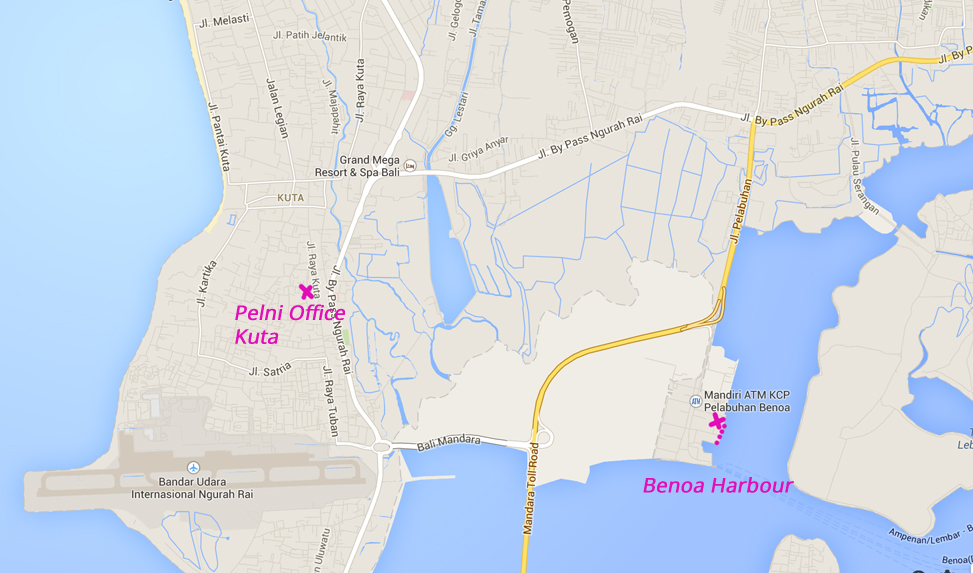
Getting information and tickets was quite a bit of a handful as everyone seemed to know where the Bali Pelni ferry office was, but no one could actually get us there. There are a few strewn across the island: Benoa harbour’s branch was always closed, the travel agent on the way to the pier had no idea what was going on, and everyone we asked were keen to convince us that their version of geography that happened to contradict all others including a map was in fact the one to take note of. “Oh, yes, it’s right across the road from Supernova shopping centre (a TINY crumbling mall with next to no outside signs, why would you need those?), you can’t miss it” actually means ‘nowhere near Supernova shopping centre but 15 mins walk in the opposite direction to where your new friend is pointing’.
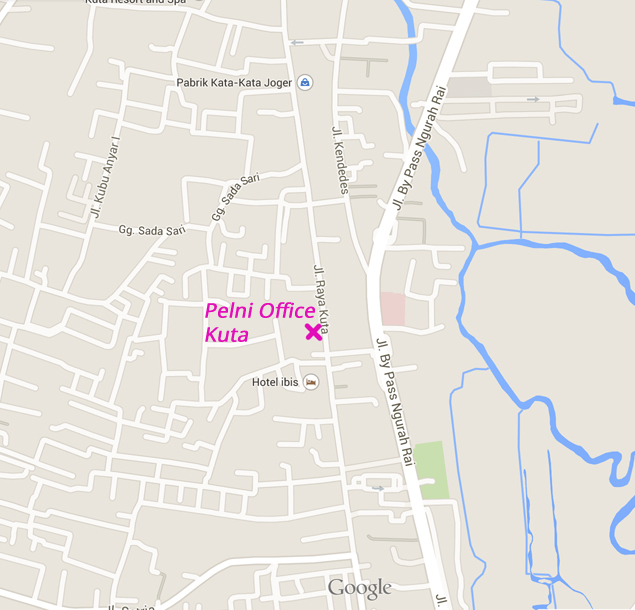
After researching for ages we found the following address for the Pelni Bali head office: JL. Raya Kuta, No 299, Tuban, Denpasar (+62 361 765758) but there are as usual several Raya Kuta roads, no visible house numbers, google maps shows this place as being another abandoned shopping mall and no one picked up the phone. Several trips and detective work on our little scooter landed us at this place further up the road – finally we had found it! Please enjoy a map and photo of the building for your viewing pleasure.
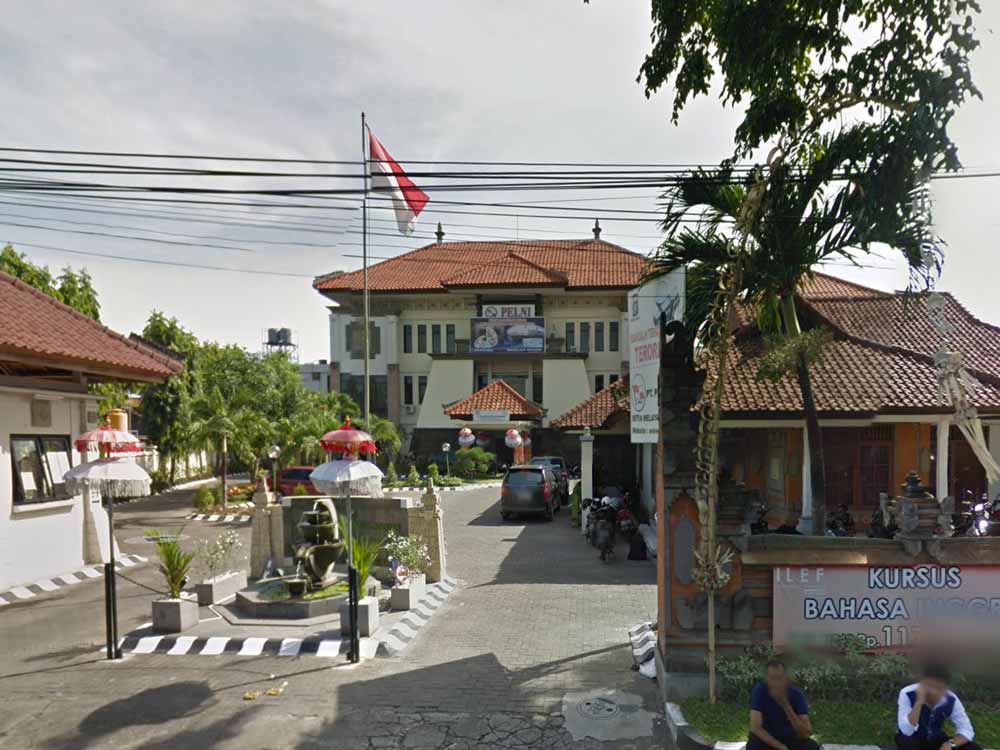
Buying tickets in advance this time (due to, you know, the whole Ramadan thing), we had the choice of economy (mattress spaces on the floor in a huge room, see this blog for pics of the equivalent class on the Batam – Jakarta service) at IDR 428’000 per person, 2nd class (gender segregated 8 bed dorm rooms, see our pics in Part 1) at IDR 1’221’500 per person or our private 1st class room for IDR 1’304’000 per person. Due to our kit needing to be secure, it was all a bit of a no-brainer. An hour later, minus a wad of cash (no cards again!), we left Pelni head office with a pocket full of rainbows, namely our first ever first class tickets to anywhere.
Chill in Bali for the required amount of time to get all excited about getting on a ferry into the darkness. Check out some surfers; don’t get mugged by the monkeys at Uluwatu temple (unless you’re into that kind of thing).
On the designated departure date, take a Blue Bird taxi to Benoa Harbour, check whether the boat is there yet and if not, grab a bakso from one of the shops by the carpark. Our boat, just as our previous one from Batam ended up arriving more or less on schedule at our final destination, but was 5 hours late leaving. We had heard rumours that being as early as possible is imperative as even if you have a ticket, you’re not guaranteed a place. No pressure then – chill with everyone else and sitting on the pier.
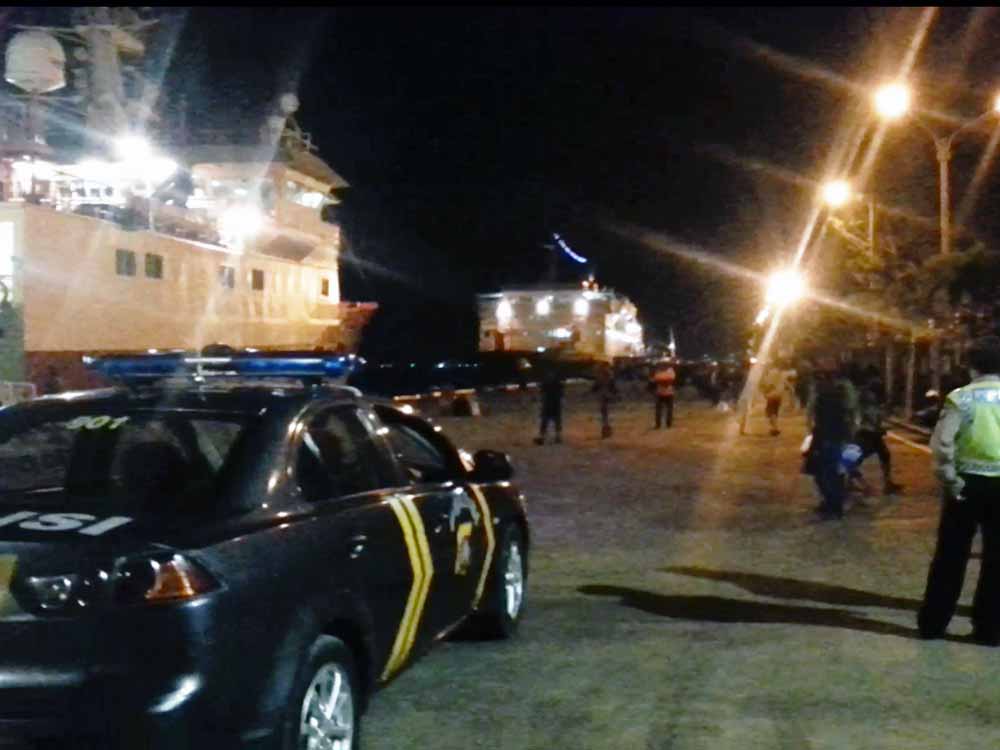
OUR BOAT TO TIMOR! (at the end of the pier)
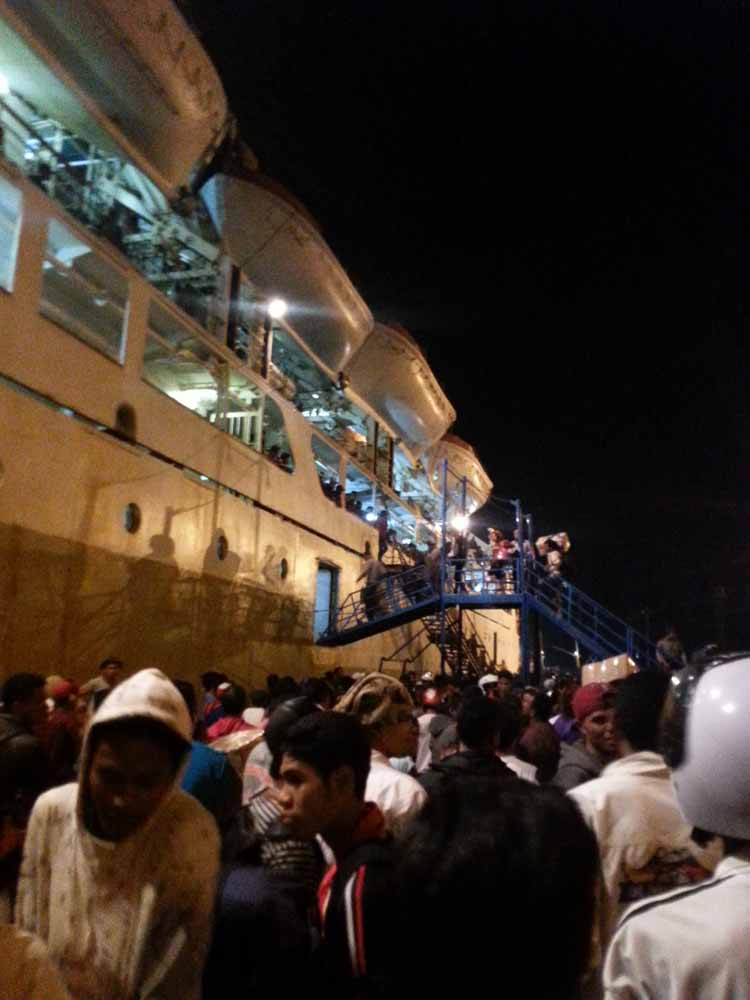
If you thought getting on the boat in Jakarta was fun, you’re in for a treat. As thousands push their way onto one tiny one-person-wide gangplank with no sense of queuing, be prepared to have boxes, kids bicycles and bags of chickens rubbed in your face from all directions. There are a few guards peeling off people climbing the outside of the gangplank to queue jump, but we were separated just before getting onto it which meant Nicola was waiting just inside the heavy metal doors of the boat for 45 mins before Saxon managed to make it.
Make friends with the angry guy in uniform blowing his whistle aggressively and shouting at everyone. For good reason – getting on the ferry seems to be a nostalgic extension of the mosh pit that was queueing for the kiosk in primary school. The moment everyone finally gets into the ferry, they don’t move to their berths but block the entrance whilst shouting at their particular friends to catch up. Lots of laughter again, we learned later this was all part of ‘national tradition’.
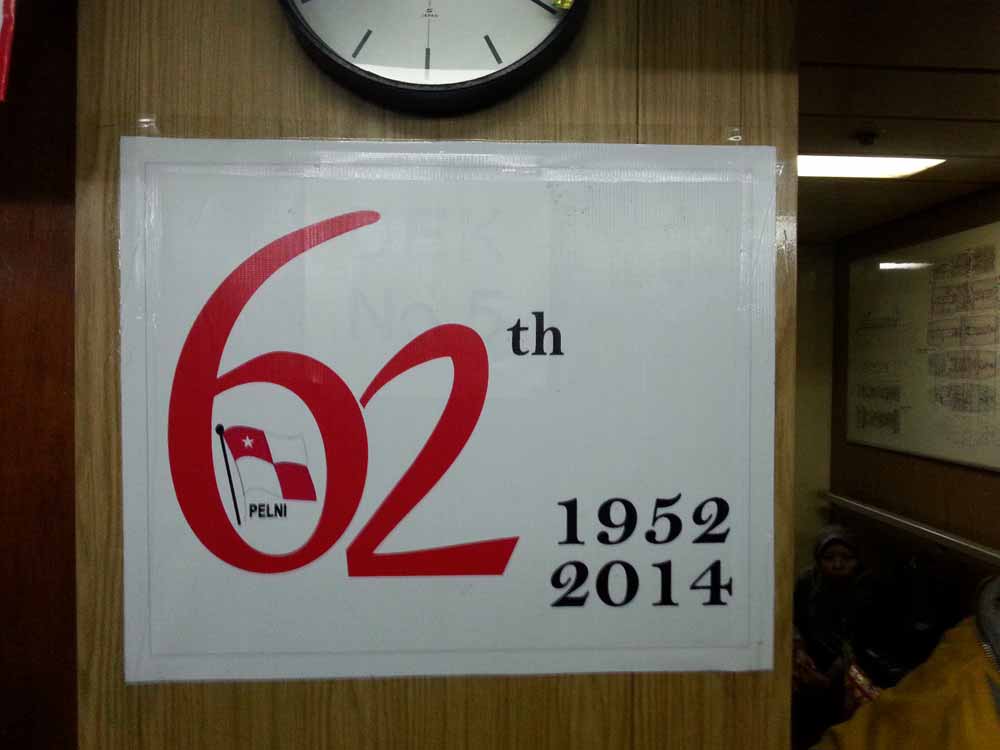
Maybe the ‘no space for late comers’ rumour had been going around. Maybe everyone was keen to celebrate Pelni’s 62th anniversary. Either way, join the party.

Our cabin was fantastic, we even had blankets, electrical sockets (bring a multi-plug!) a little desk and a TV that showed an exciting feed of the empty the dining area. It was rather hot but the group of rowdy teenagers camped on deck outside our window playing Angry Birds Star Wars Edition on their Samsung tablet was a little windswept and cold, so choose a location to suit your personal climate preferences. Outside may also have been a little bit too loud to hear the rooster crowing on one of the lower indoor decks. The metal hull reverberated perfectly every morning in a glorious unison of machine and beast. Who would have thought.
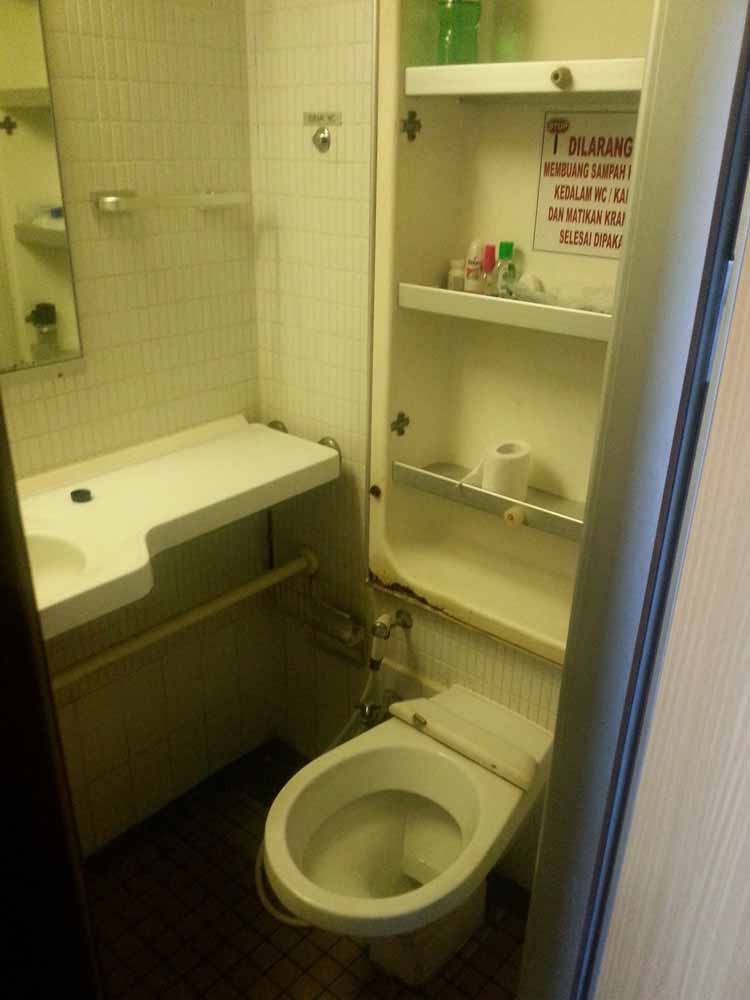
This particular ferry did suffer from a recent invasion of toilet-seat stealing elves. To compensate, there was small cold water shower and sink – all very shabby but a real upgrade for us so we were over the moon.

Cone-hair lady disapproves of you standing on the bed.
If you are travelling 1st or 2nd class, enjoy free of charge breakfast, lunch and dinner in the dining and entertainment area at the rather odd times of 7am, 10:30am and 4:30pm. Fish, chicken, rice, unidentifiable vege and some fruit for dinner desert. Alternatively (or additionally) ask the kitchen for a flask of boiling water and cook your own pot noodle but note the dining area is used for other events such as Christian sermons and group talks at non-feeding times. Muslim prayer times are announced throughout the day via the ferry’s loudspeaker system as a room large enough to hold all devotee passengers would be the size of the boat. So they use the boat instead.
Note also that the price of food and drinks brought from the shop may vary depending on the level of your tan and Indonesian language proficiency. Smiling and politeness always help, even if it means an enthusiastic fellow passenger offers to take your coins and buy things for you. Friendly banter is a big part of the trip, so don’t be shy, dive in and get involved – you won’t regret the enthusiastic mass movement you’ll become part of within minutes. Loading and unloading times are always especially exciting.
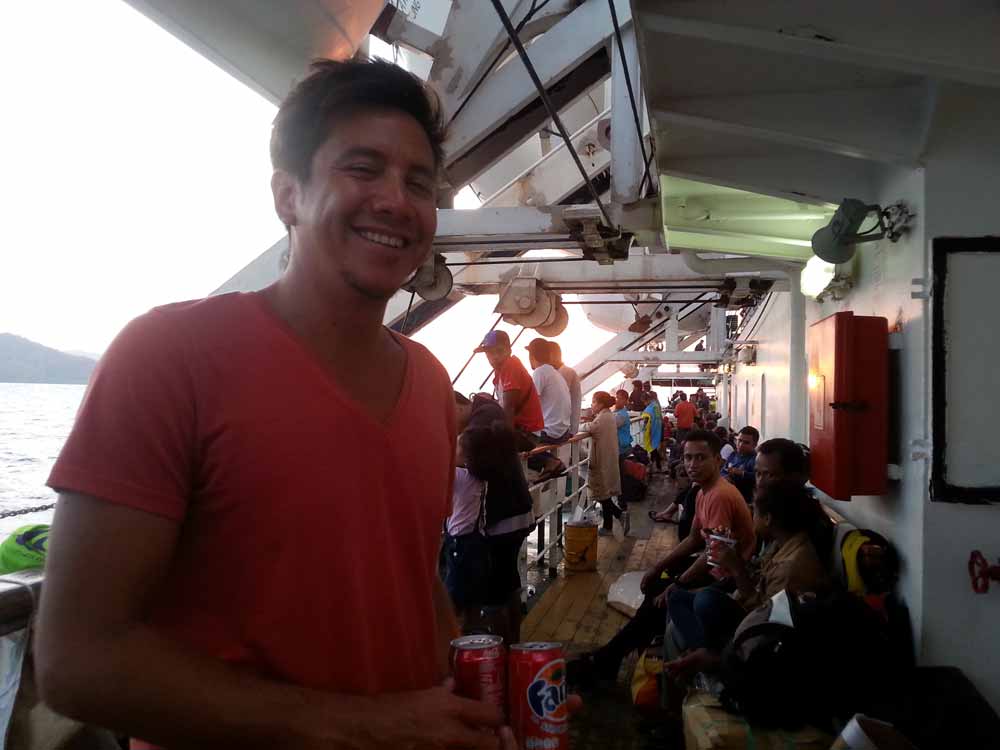
Jump off in Bima to access the Komodo Islands or sail past them down to Waingapu. Yes, this is a real name of a real place. So is Cockfosters on the Picadilly Line. Enjoy the view of the sunrise with everyone else, especially those with pole position having set up camp inside the lifeboats. Be proudly told by said pole positioners that it is far less breezy than on deck, so they push one person up the gangplank early to reserve lifeboat 17F (visible in the top left above Saxon’s head) every year.
Jump off in Waingapu to explore the Island of Sumba at your leisure. We have it on good authority that the local horses are pretty special.
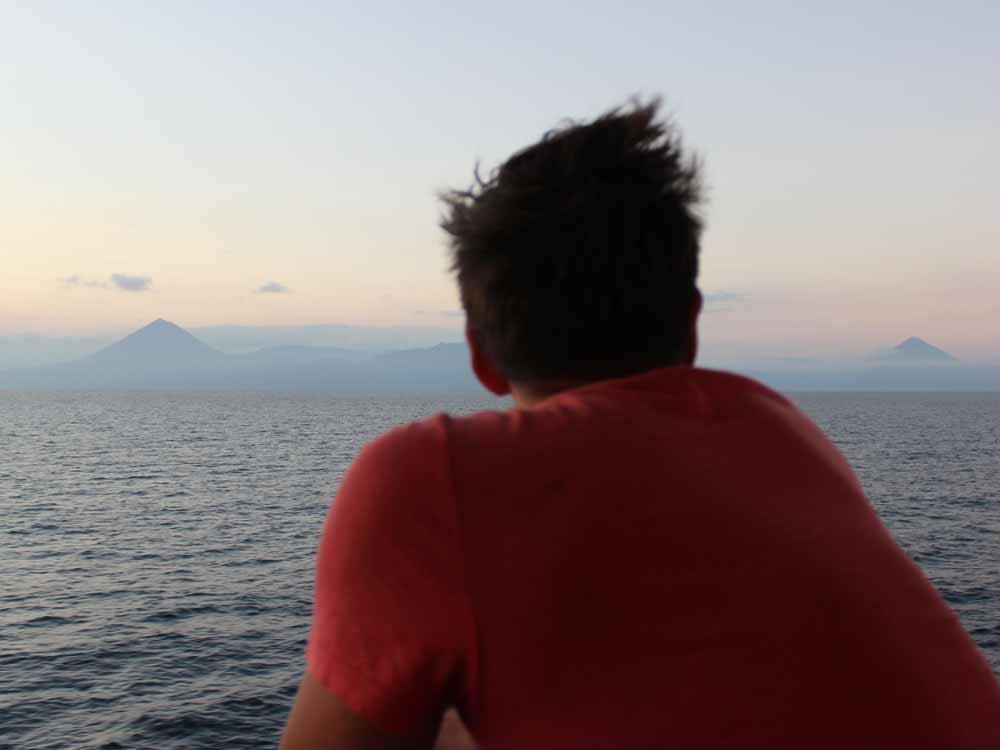
Wear the same T-Shirt as on every other photo during this month and enjoy the view of Flores Island on the way to Ende. Double volcano action, dudes.
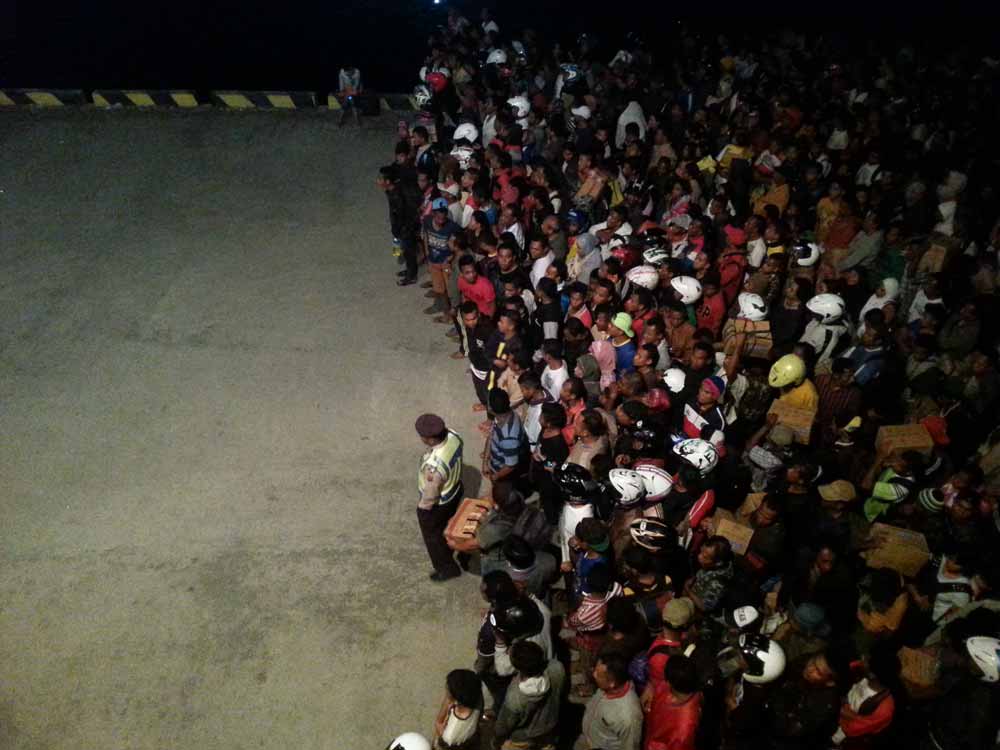
Disembark in Ende for the Flores volcano experience. Marvel at the harbour authorities’ incredible talent to make everyone wait and let people get OFF the boat before they try getting ON. Three cheers to the crowd for remembering to wear their motorcycle helmets whilst boarding. Safety first. Especially when climbing up the side of the gangplank with a security guard clinging to one of your legs whilst your friends and other guards point and laugh. Tradition, remember?
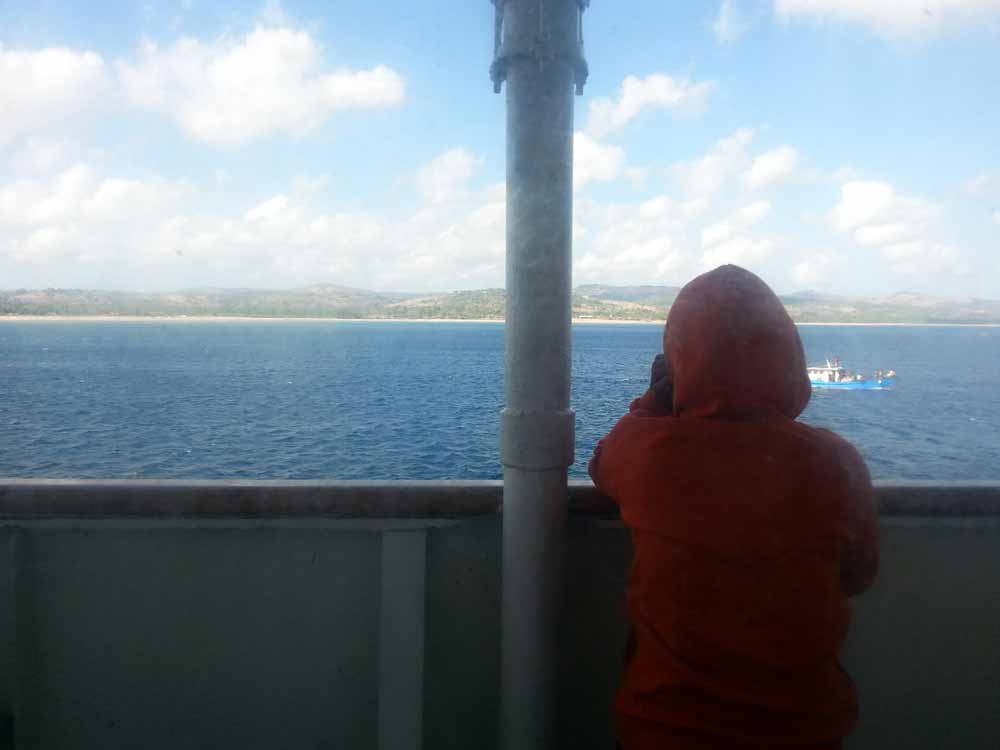
Join one of the now melancholy teenagers camped outside your window and enjoy the view of flat, non-volcanic Sabu together. Exchange Instagram details. Take pictures with everyone in various combinations. Don’t forget lunch at 10:30am.
Go nuts on Sabu for the desired amount of time. Possibly for at least 3 weeks as there don’t seem to be many other boats coming and going. Some good surf and an airplane connection to Kupang as well as being very much off the beaten track (you did ask for it!). Or keep going till Rote and surf the well known breaks as it has many more frequent connections via boat and plane to Timor Island.
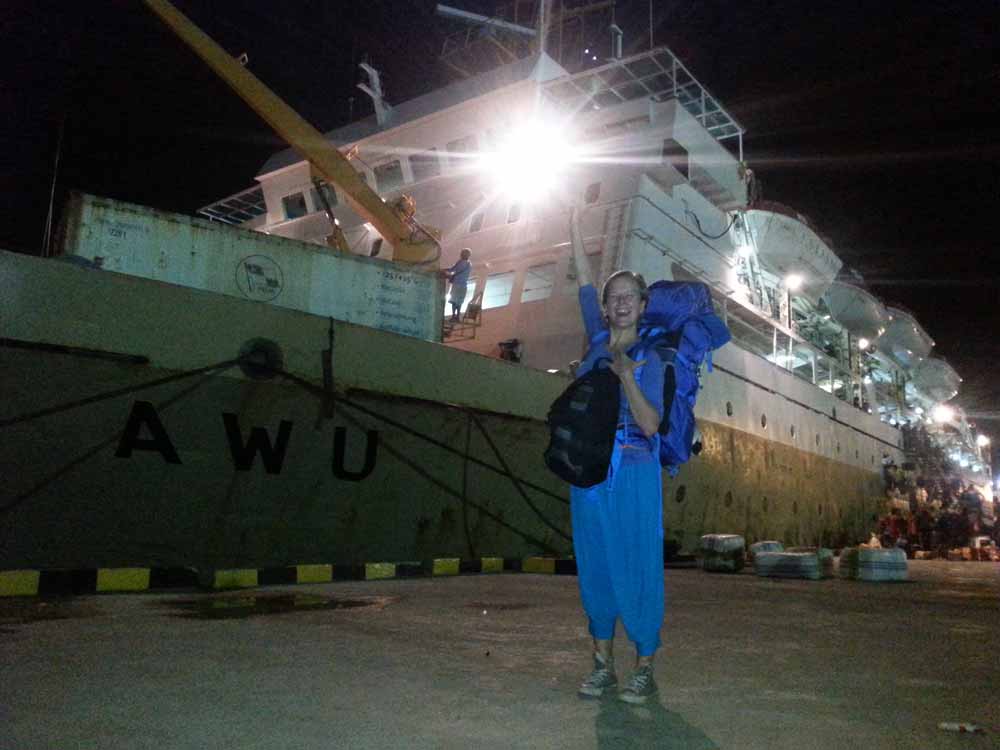
If you’ve come all the way with us keenos to Kupang – 73 hours later you can give yourself a huge slap on the back as you have made it! Welcome to Timor, welcome to Kupang, congratulations, you’ve survived three days straight on the ferry. Double congratulations if you chose economy class and an extra gold star if you got to sleep in the lifeboat.
Timor to Timor Leste: Minivan
1) Apply and receive Timor Leste Visa Application Authorisation, allow 3 days, free
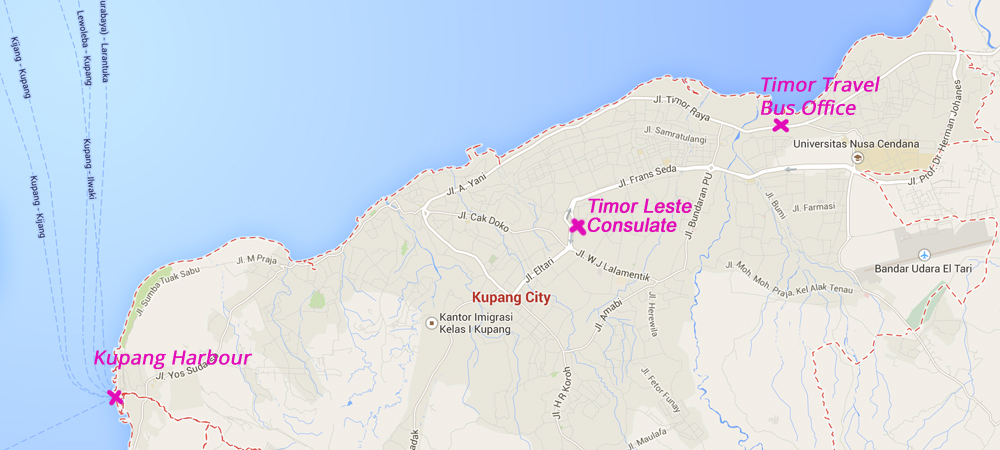
In order to travel to East Timor, you must first acquire a ‘Visa Application Authorisation’ letter from your nearest Timor Leste Consulate. YOU CANNOT JUST ROCK UP AT THE BORDER. Find full information on the official Timor Leste Immigration Authorities website, but in a nutshell, download the application form, fill it in, get copies of all supporting documents (passport copy, bank statement, return or onwards ticket etc) and take a bemo to the Consulate of Timor Leste, Jl. Eltari II, Phone: + 62 8133 9367 558 / 8133 9137 755 (neither of these numbers worked though). Here is a handy map as taking pictures of the yellow building was prohibited by one of the more Rimmer-like guards.
For those now scratching their heads with a ‘WTF Mate?’ look upon their face, a ‘bemo’ is a shared minivan-taxi-public-bus-hybrid popular in Timor. Those lucky enough to have visited Bali 10 years ago will have seen them shipping rowdy tourists from bar to bar, but they seem to have disappeared this time around. Possibly due to something accident related. Taxis are often private (Blue Bird has unfortunately not made the leap to Timor yet) and charge a minimum flat fee of 50’000, even for 2 minutes down the road, so cuddling up to smiling local youths, business men and a nun or two for 2’000 pp is a lot more fun. Plus Kupang’s bemos are fully pimped out with Avril Lavigne stickers, Jesus slogans and more cuddly toys you could ever imagine. Not to mention the impressive sound systems pumping out Vengaboys giving all passengers free tinnitus.
Wanna see what ‘Pimp my Ride’ Indo-style looks like? Check out our Bemo Boys Place Cake:

Submit your application to the friendly man at the window, and if you’re friendly back the office may be inclined to speed up your application process (expect nothing, ask politely but be prepared to wait). Once approved, you’ll be able to pick up a document like this from the same window a few days later:
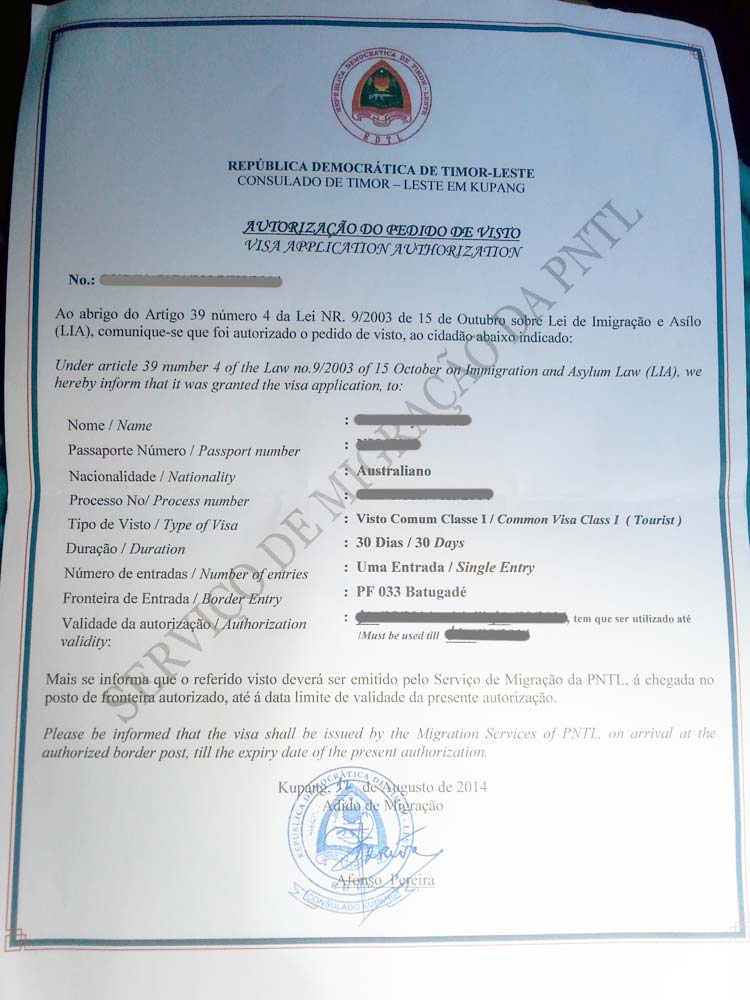
HURRAY! Don your ‘I’m all official now’ t-shirt. Only now can you go to the boarder and get a visa. To do so, book your minibus and stop…. *beat* Hammertime.
2) Minibus from Kupang to Dili, 14 hours, IDR 200’000 pp
There are several public transport options you can piece together a route from, but they will most likely require an overnight stop off in Atambua. If you have the time, great! The landscape is stunning, especially starting from Soe. If you don’t have the time, take the designated minibus service all the way.
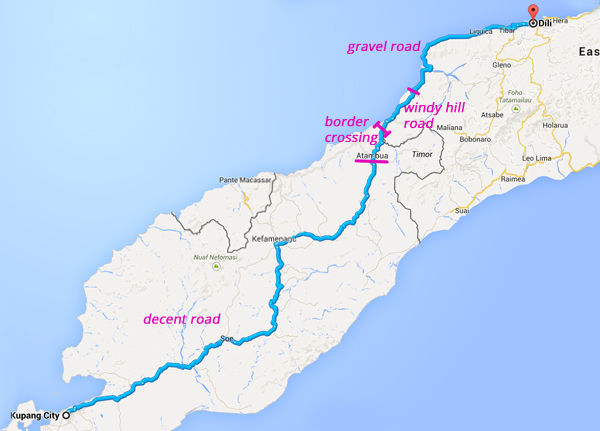
Challenge of the day: Find the Timor Travel Minibus office. You know the drill – no discerable house numbers, no one picks up the phone, about 5 different road names to chose from when naming hundreds of roads around the city… here’s the address for completeness’ sake: JL Timor Raya No. 8, Tel: 0380-881543, 882125, 8080345, 8080850. You may have more luck than we did. If not, despair not. Here are more pretty pictures.
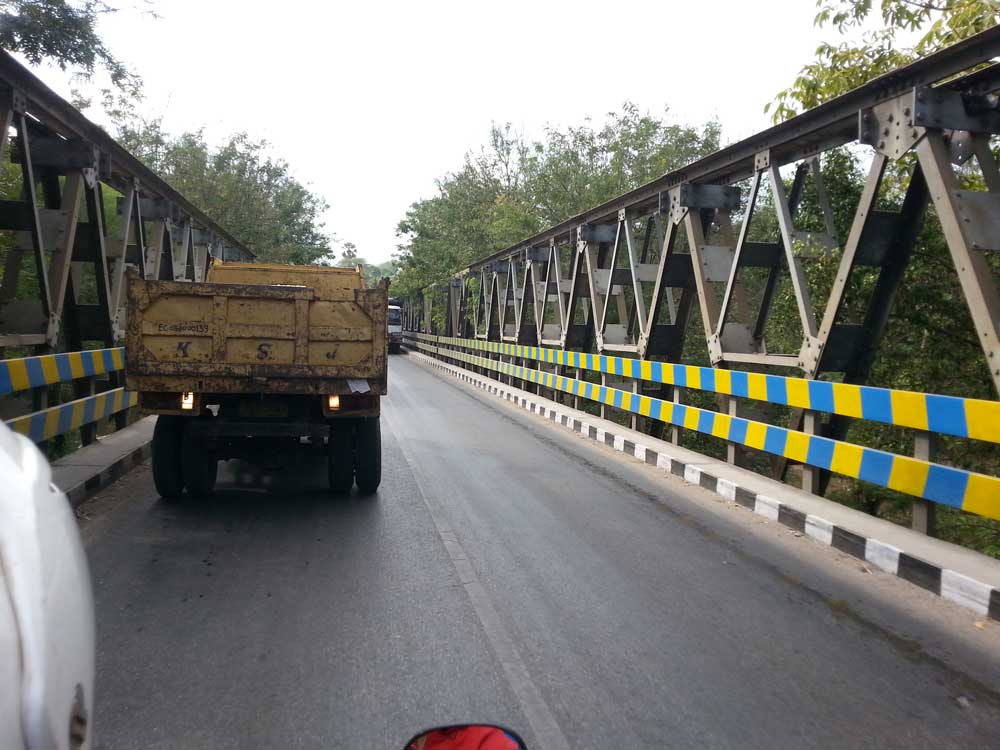
Take a bemo along Jalan Timor Raya away from the old centre of town until you cross this bridge. Then keep your eyes peeled for what most certainly is…
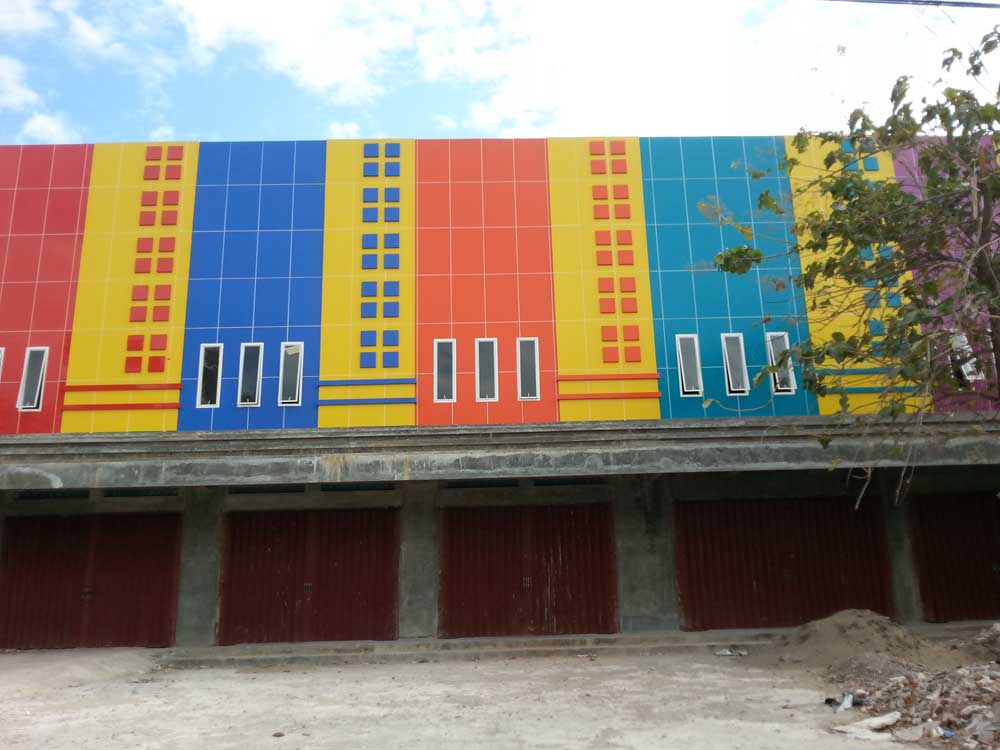
… the most unnecessarily coloured building of questionable purpose this side of the river.
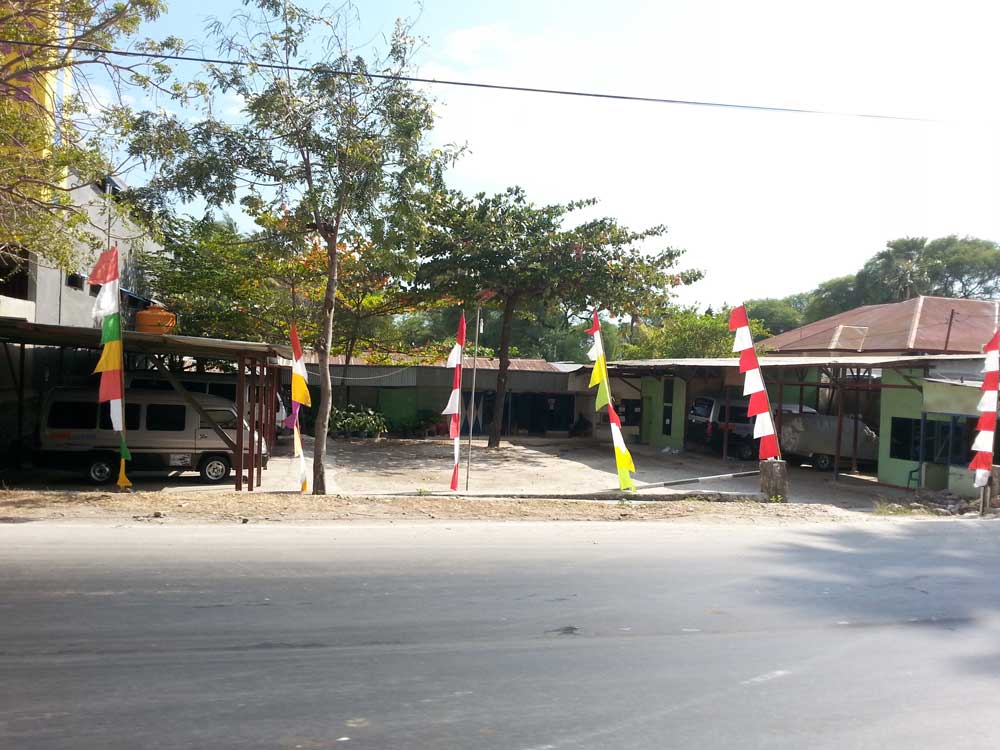
Right next to it you will find this un-assuming little car park.
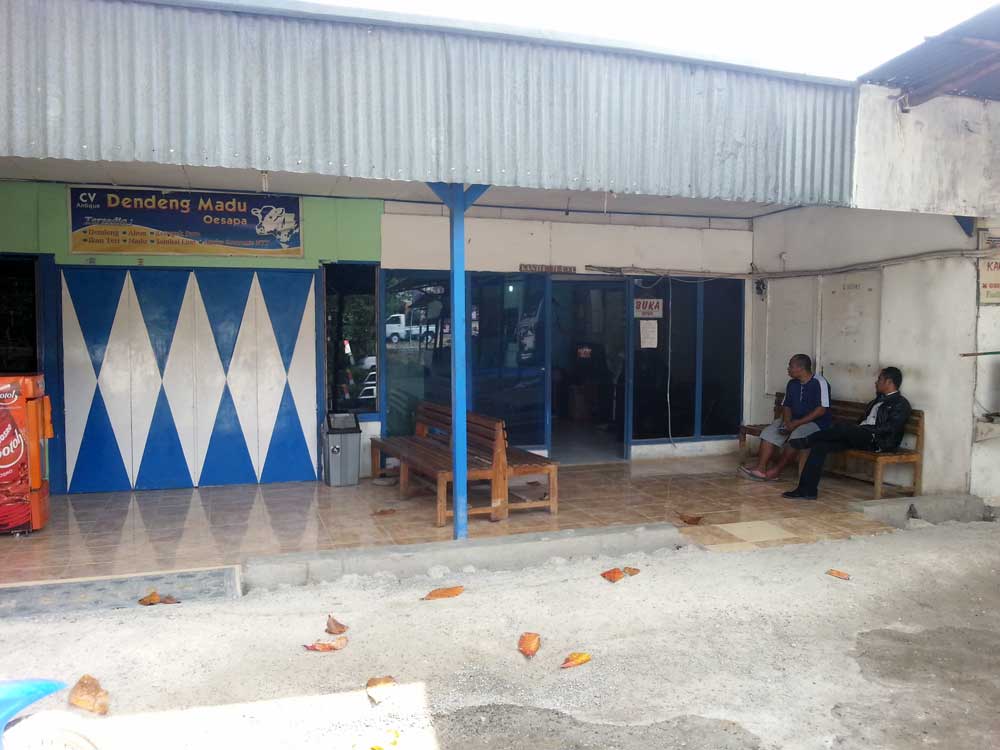
In the back on the right there is an office. Go in. Say hello. Don’t be shy, this ain’t Corleone’s.
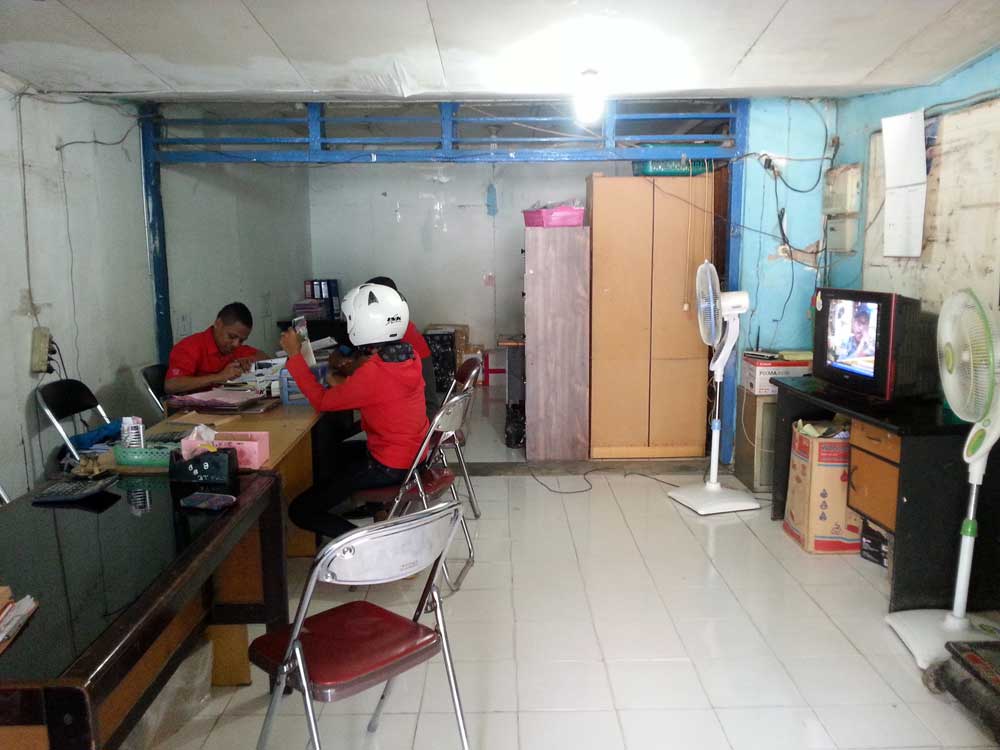
Purchase Timor Travel Minivan tickets on your preferred date (at least 24 hours in advance as busses leave at 6am before the office opens for the day). Motorcycle helmet is optional.

On the day of your travel, you will be picked up by a nice gentleman from your hotel about 2 hours before you actually have to go. Bring copious reading material. Once everyone has been rounded up, you will be transferred to this minivan. Receive a muffin and water in a cute little pink cardboard box with flowers on it for breakfast (subject to availability). Your journey has officially begun.
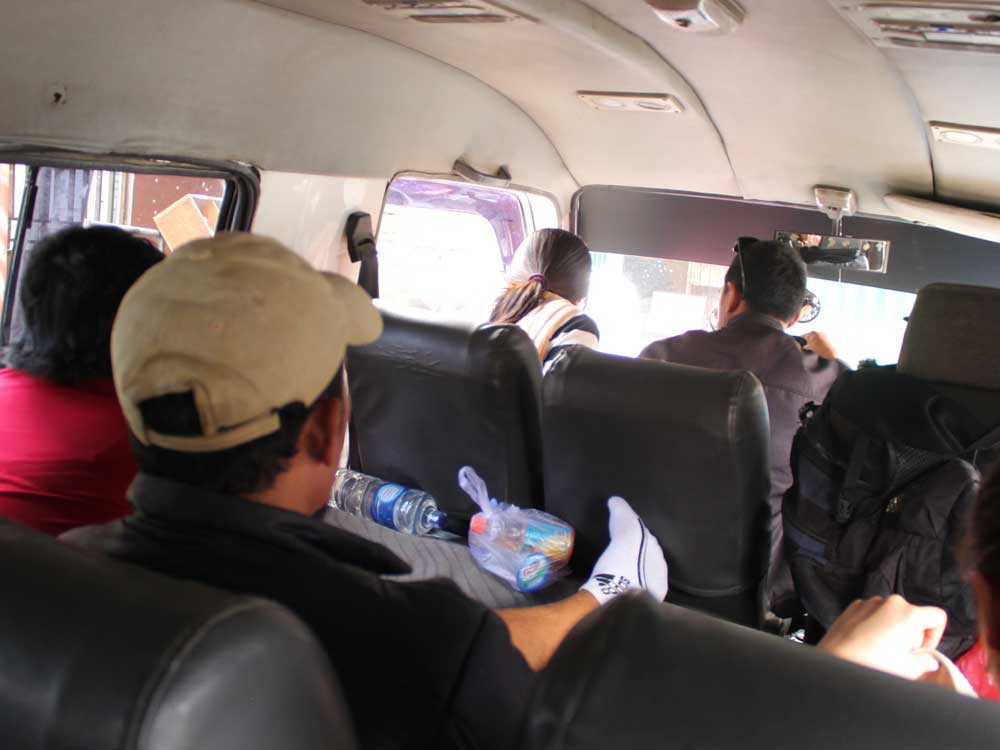
Make yourself comfortable in the minibus but note they often sell out so stick to one seat as people are picked up along the way. Only take front seat if you are in a particularly chatty mood or a big fan of the local radio station that exclusively plays twinkly love songs.
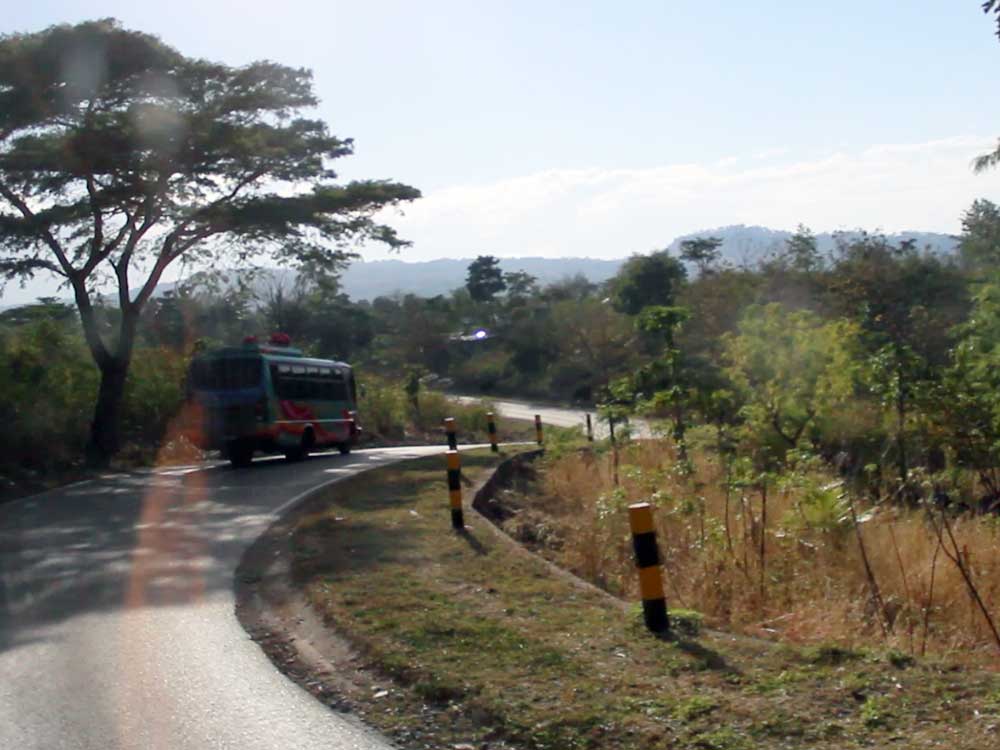
Enjoy the decent roads on the way to Atambua via Soe. Some may make you feel a little like you’re on a roller-coaster but in comparison to what’s ahead they are magic. Beware of google earth’s road layout. It may seem like the roads in East Timor are bigger than West. They are not. Check out the landscape, it’s pretty spectacular.
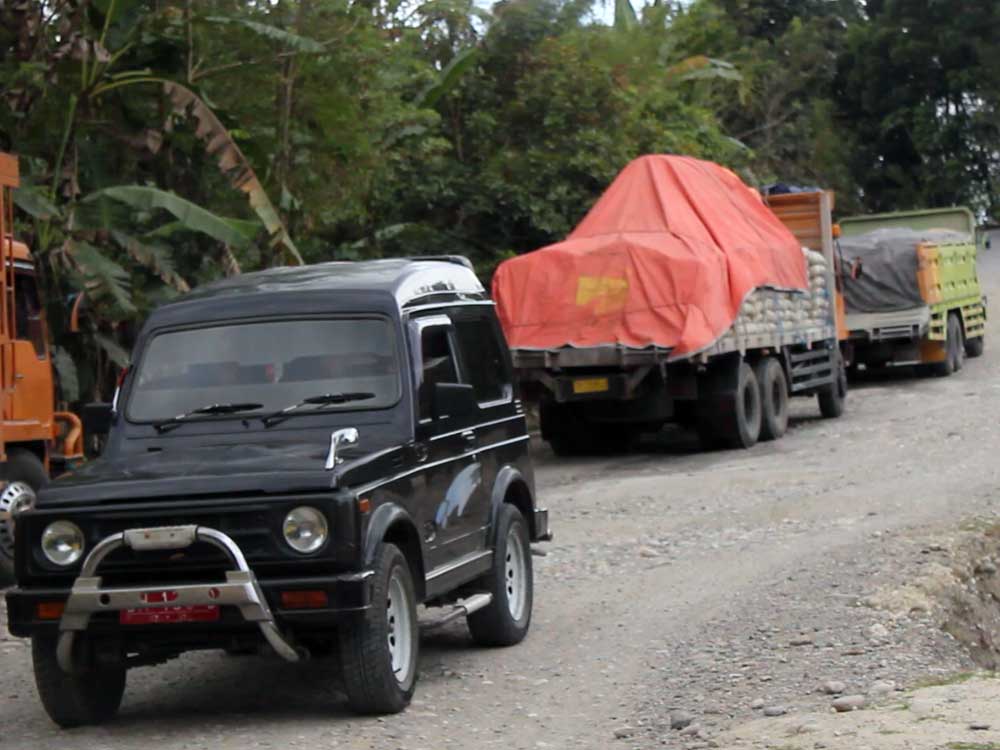
Get a glimpse of what lies ahead in some of the minor road works on the way to Atambua.
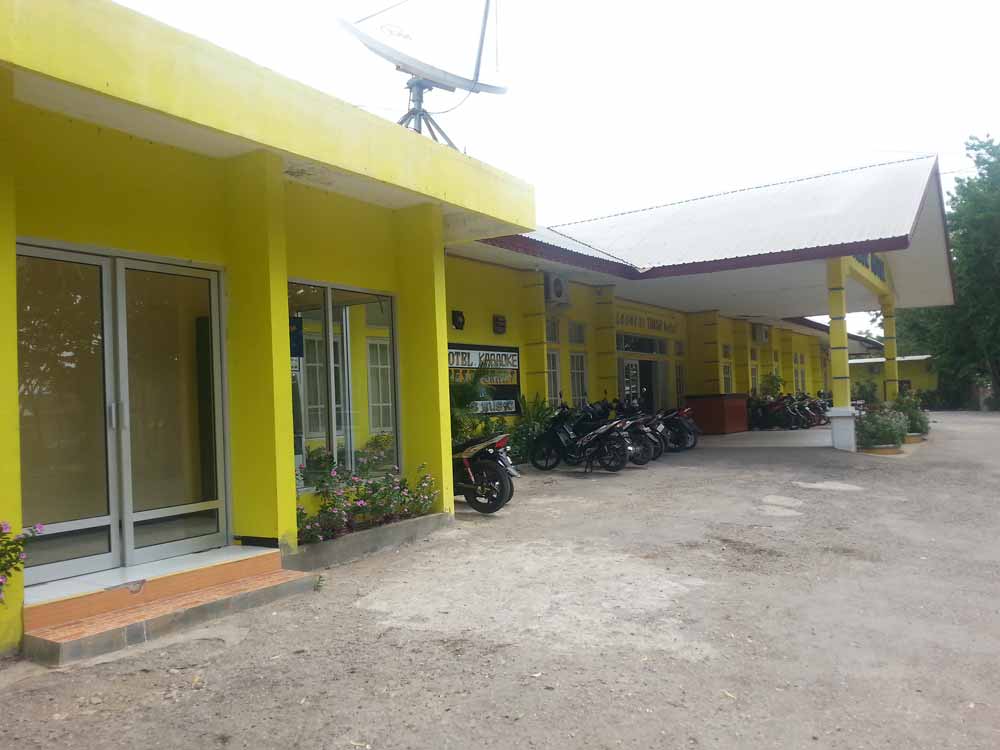
Stop off at this hotel for 20 mins for no apparent reason.

Soon after, arrive at the border.
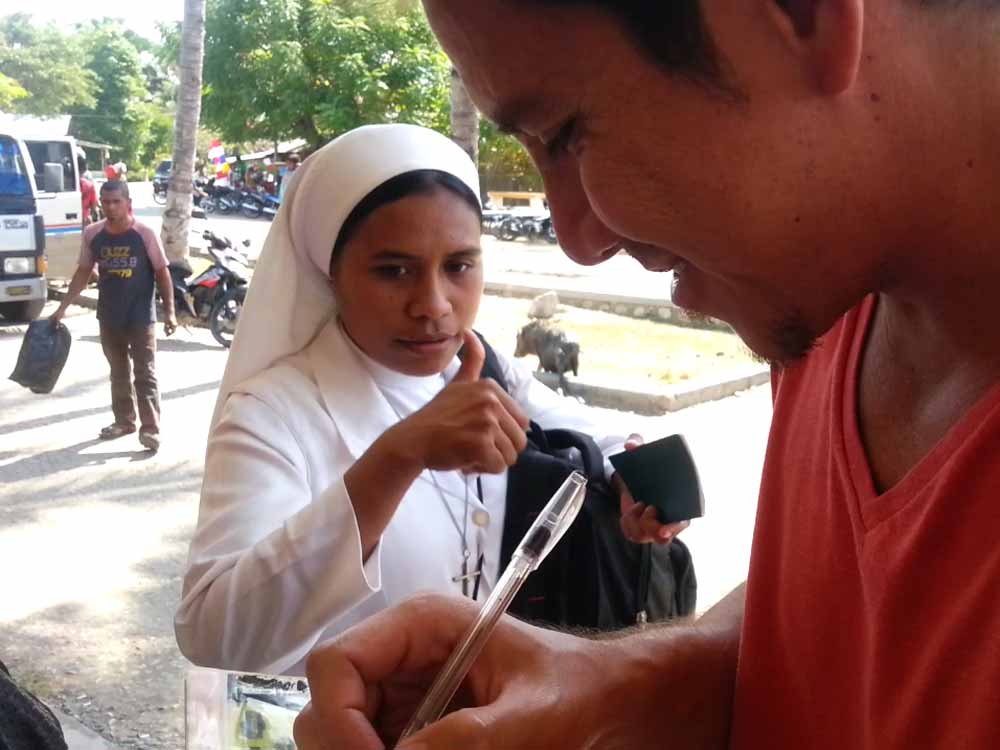
Borrow pen off rock-n-roll nun to fill in your departure card. Don’t mind border crossing feral pig in the background. No one is the boss of him.
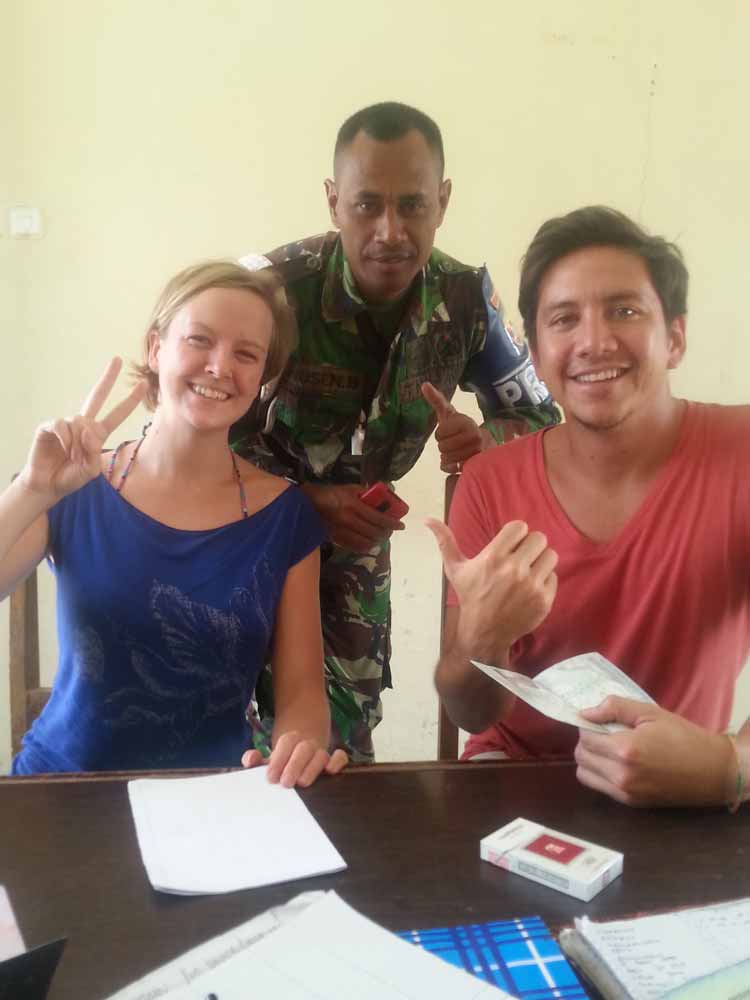
Hand in your Visa Application Authorisation. Have your photo taken with various Indonesian emigration officers. Last chance for authorities selfie time.

Cross the border, old school style. Don’t mind the feral pig following you. He owns this sh*t.
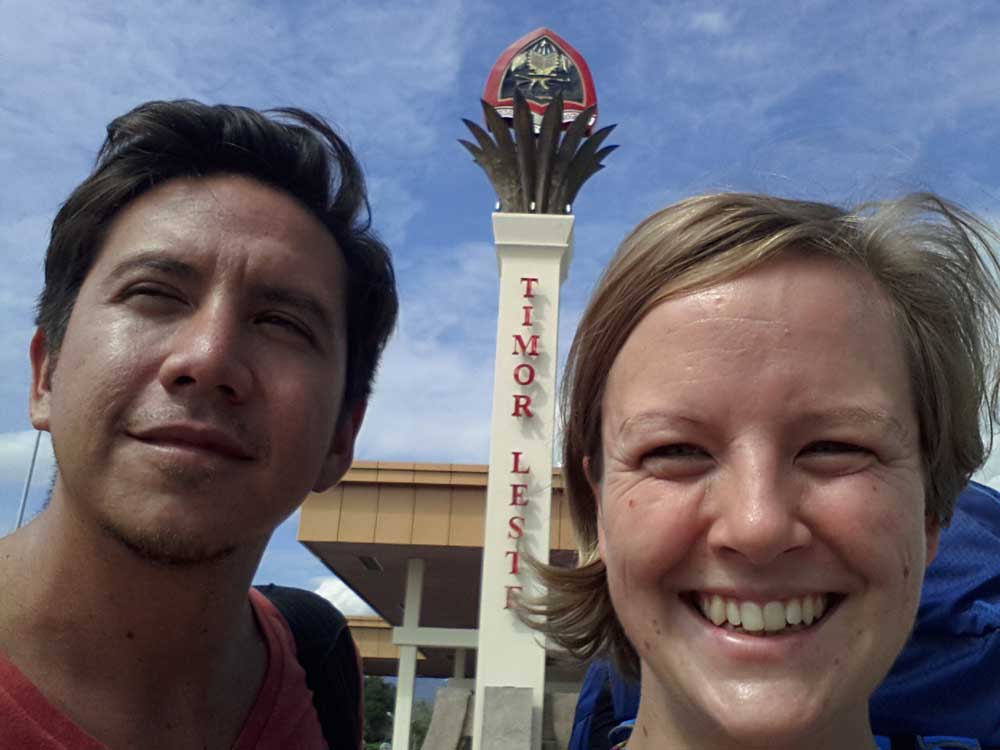
On the Timor Leste side, go to the little counter before you get to immigration and pre-pay for your visa – 30 US Dollars, make sure you have at least $50 in case officials change their mind on the day, or someone is in need of some extra cash. Karma and all that. Proceed through immigration, have your bag scanned and searched for pigs. If all runs smoothly you will have successfully made it to East Timor. Congratulations, you can now count yourself to the tiny and very special percentage of backpackers who have made it here.
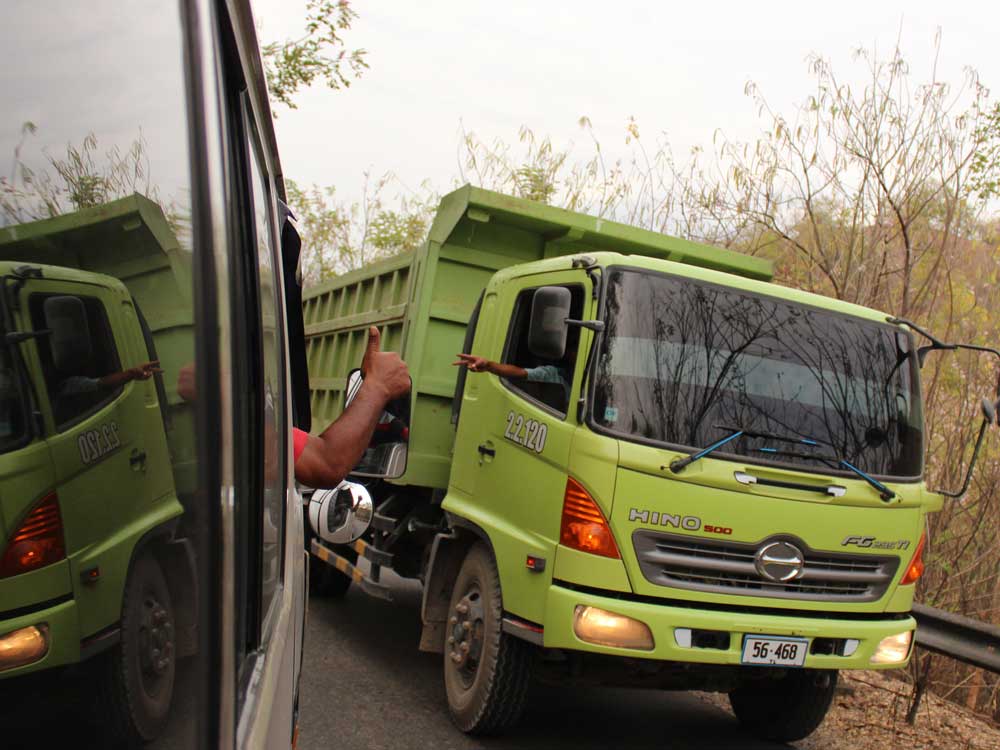
This wonderful country welcomes you first with a windy road through the hills down to the coast. Gawp at the incredible skill of lorry driver after lorry driver squeezing past your minivan and avoiding a cliff face. We counted a total of 8 in one row (currently signalling there are two left to go).
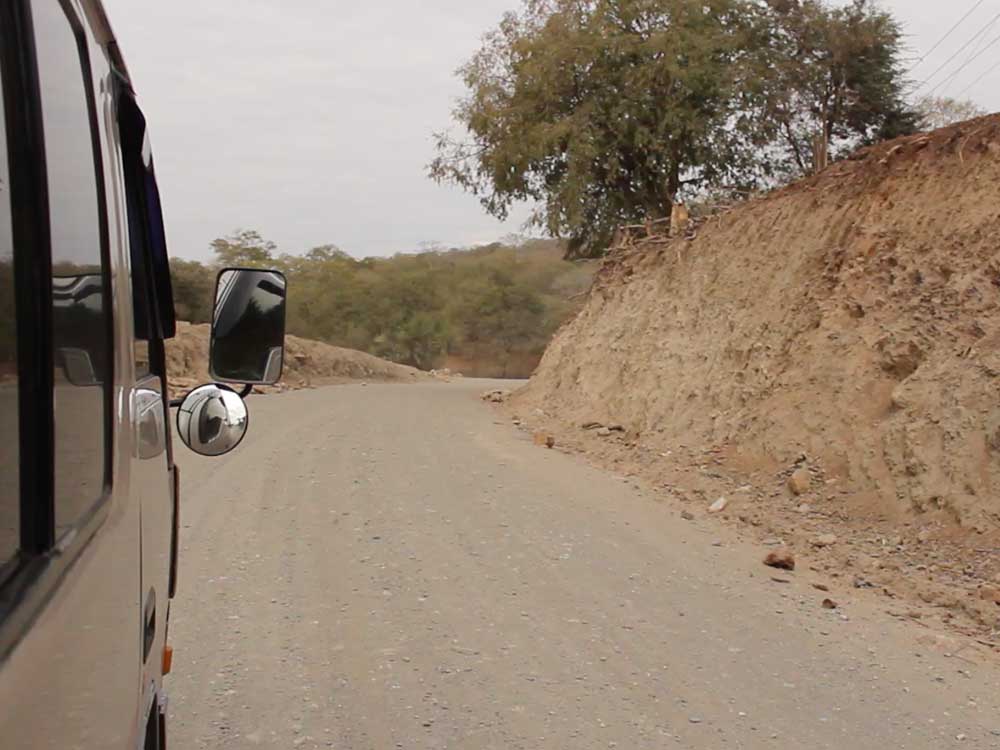
The road has been under construction for nearly a decade. No builders in sight.
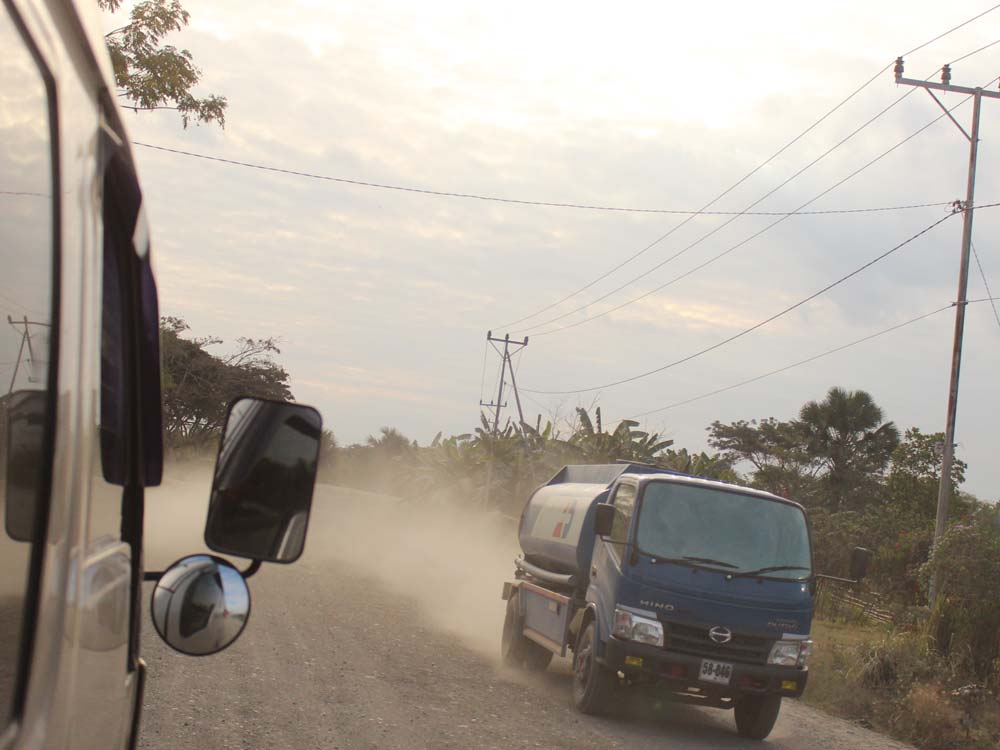
Which means lots of dust.
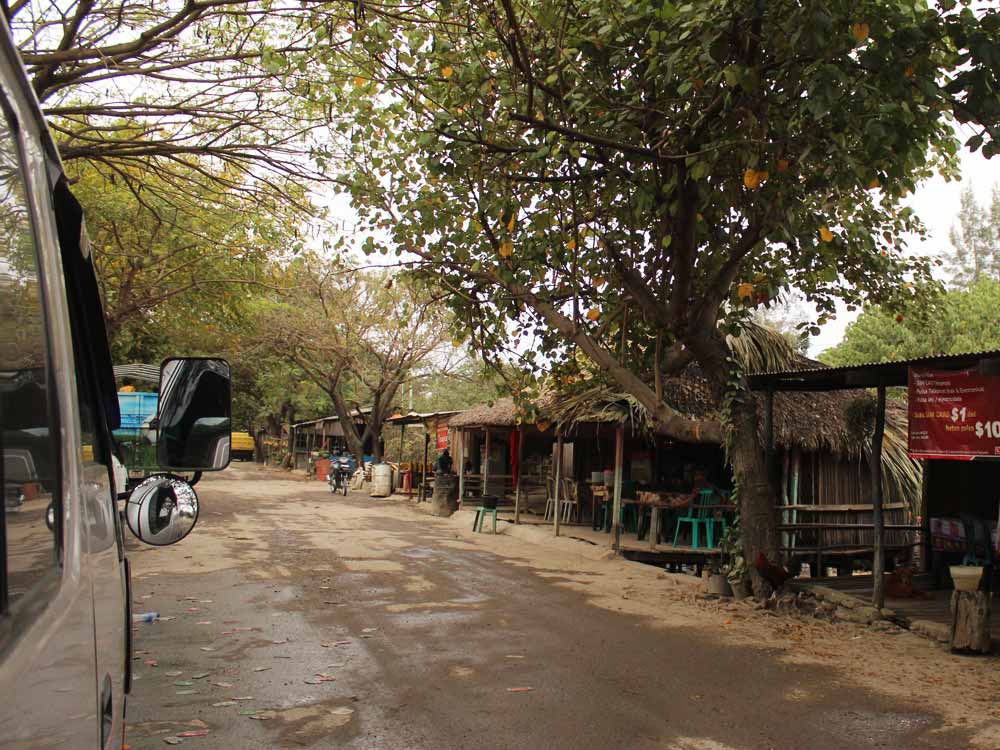
A quick stop off for snack lunch, aka a smoke for the driver.
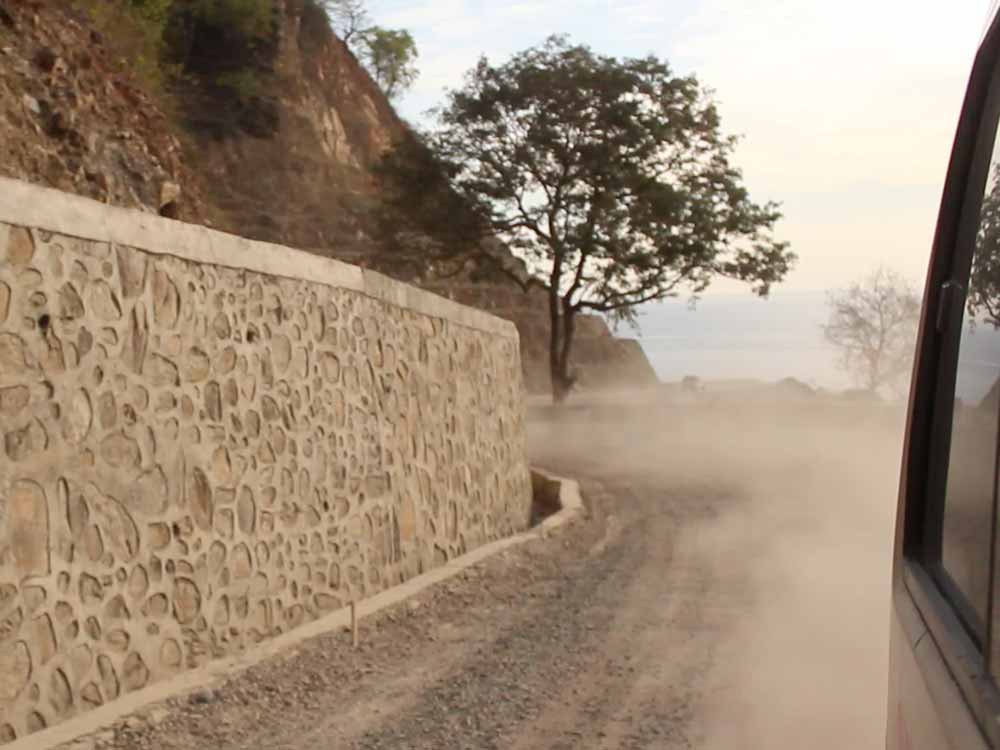
Then for some more dust.
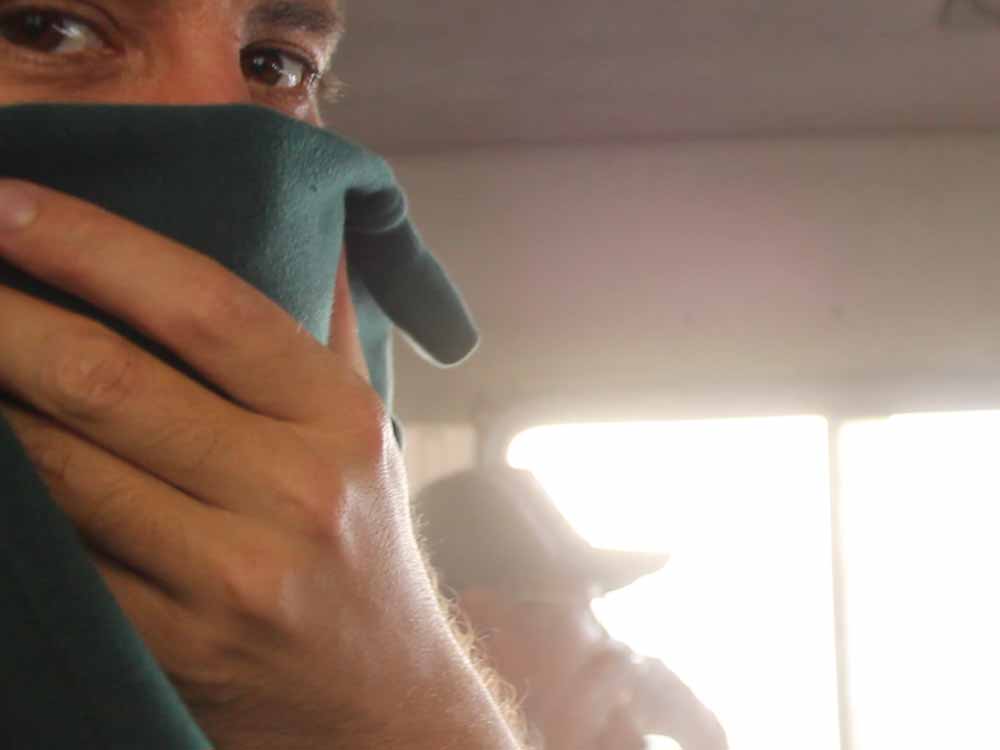
Outside the van and inside the van.
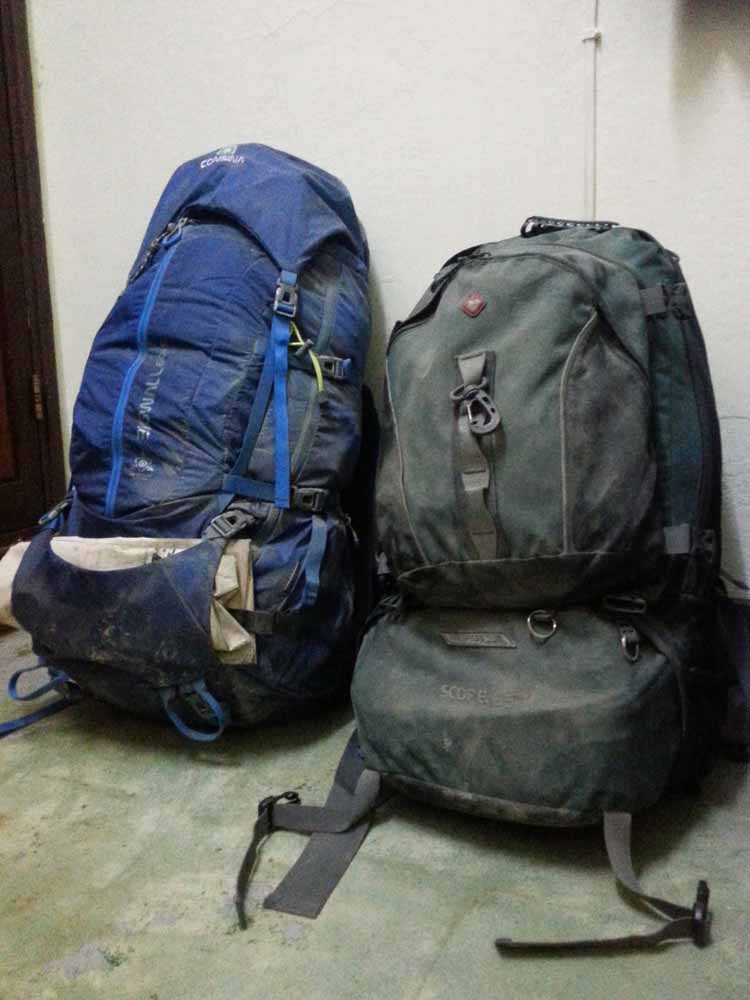
Make sure your bags are all well zipped up. The one on the right is usually very dark green and black. The left one has been cleaned and is waiting for round two.
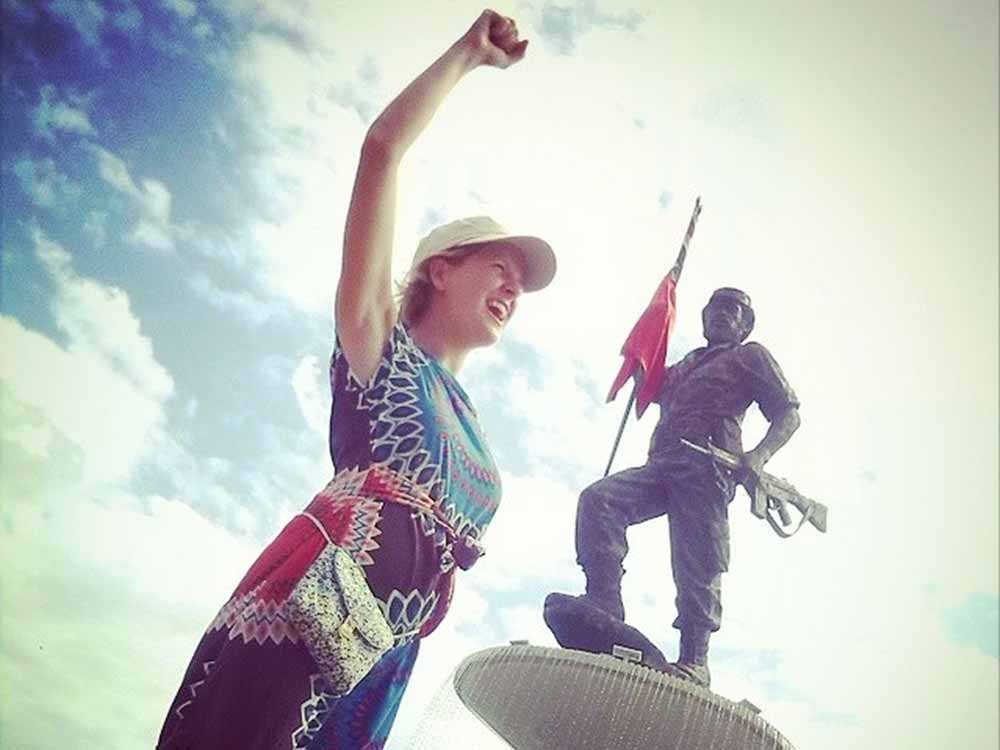
And so, dear reader, if you can see the statue of Nicolau Lobato, you have made it to Dili. In case you were wondering (as we often did upon arrival) what the local currency is and how much it’s worth, have a bit of a surprise. Timor Leste deals in US dollars, with their own little centavo coins mixed in. There are some awesome places to explore, including ‘Jesus Backside Beach’, ‘Jim’s Crack’ and ‘Ramelau’s Bottom’, go crazy.
We hope you have found our account useful, feel free to get in touch if you have any further questions. And do let us know in the comments how things went!







































